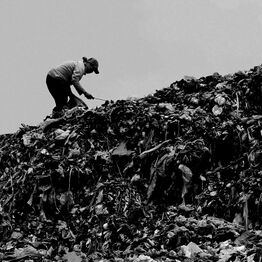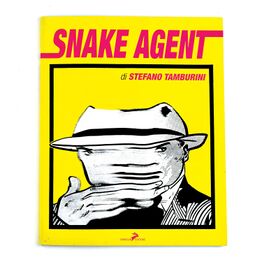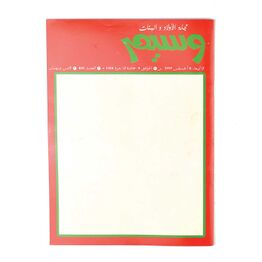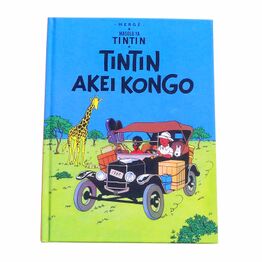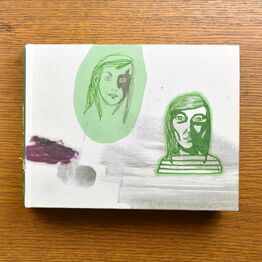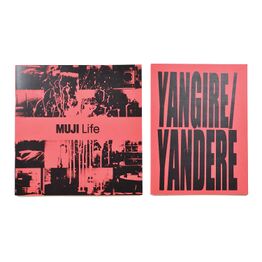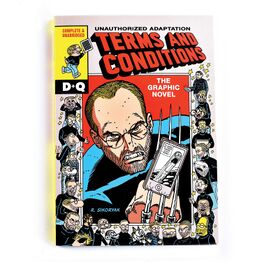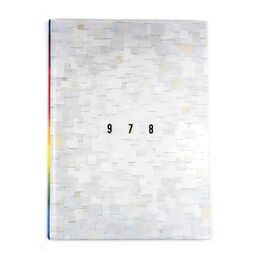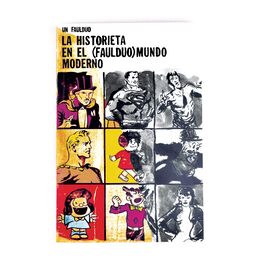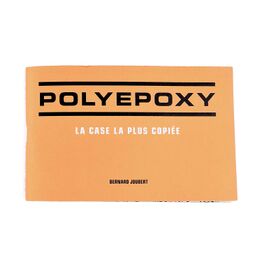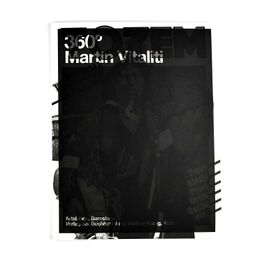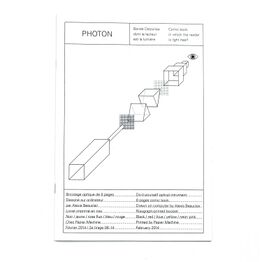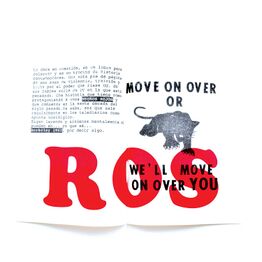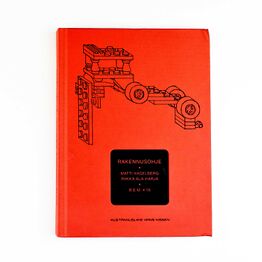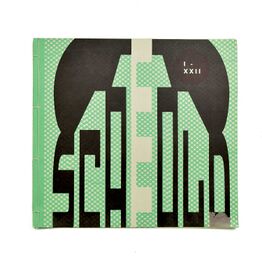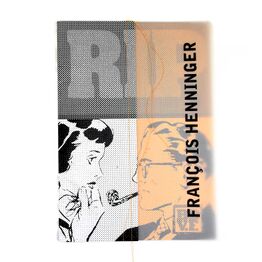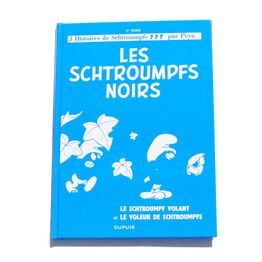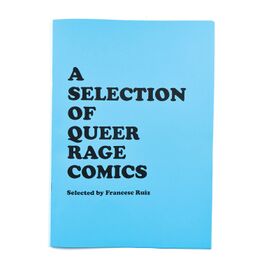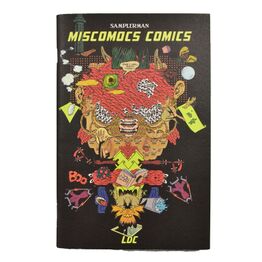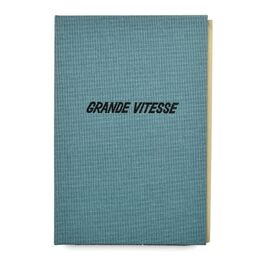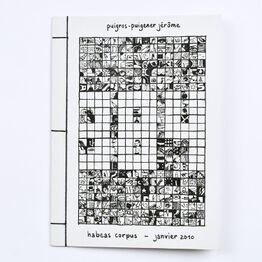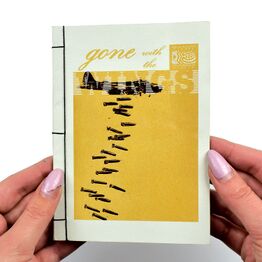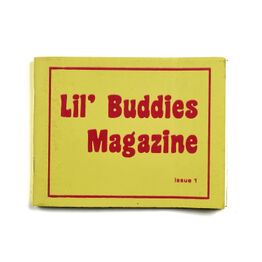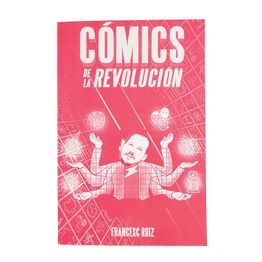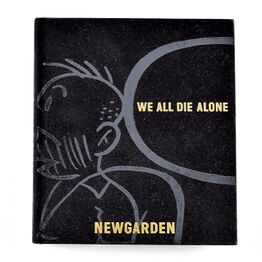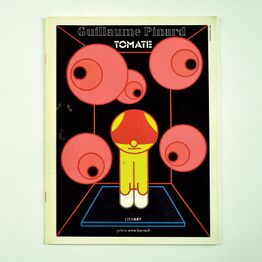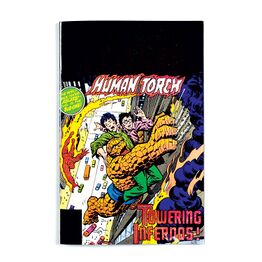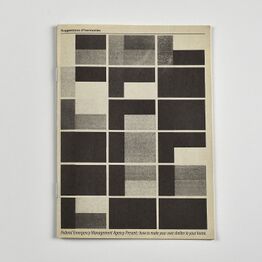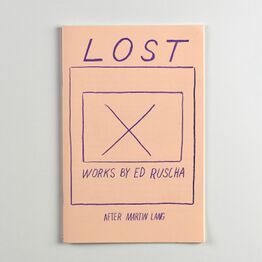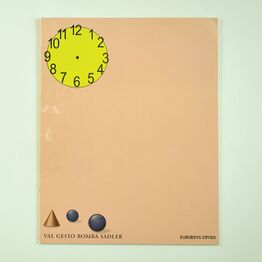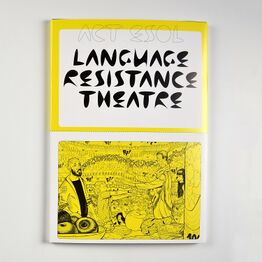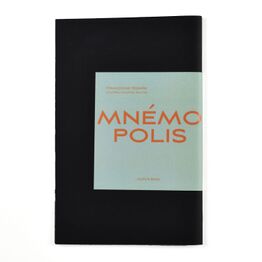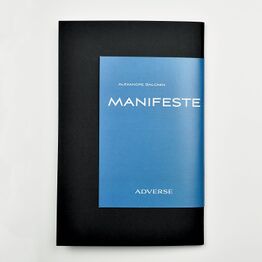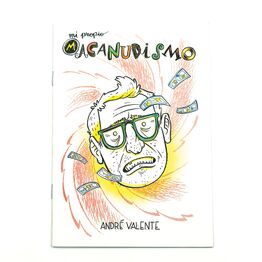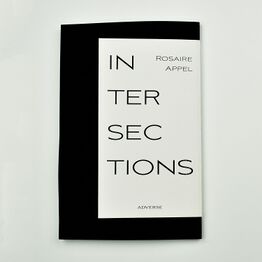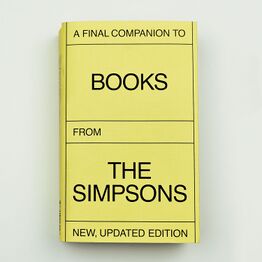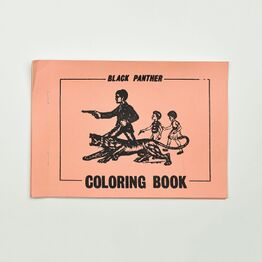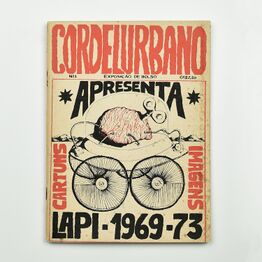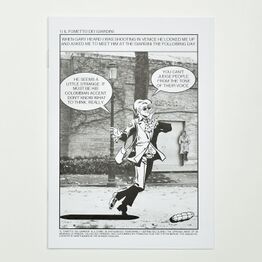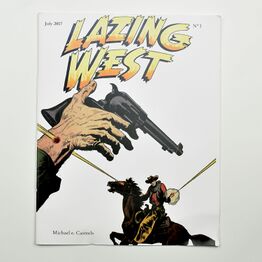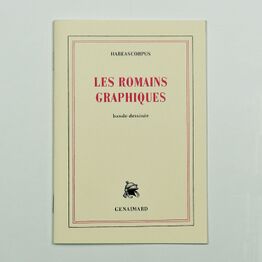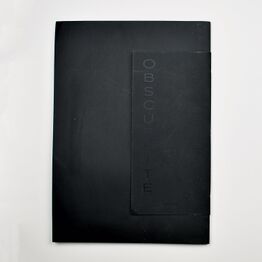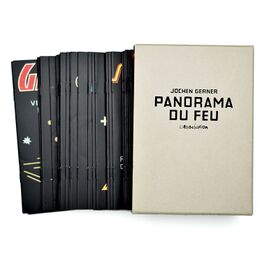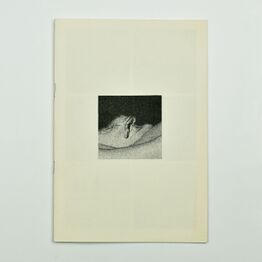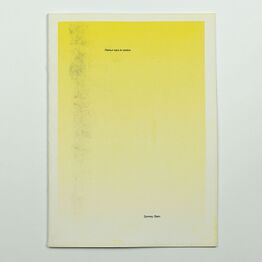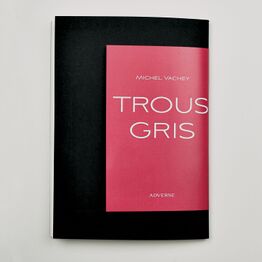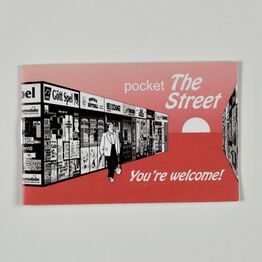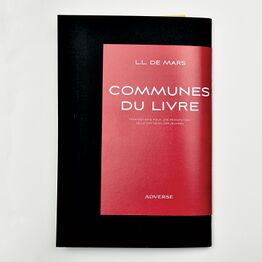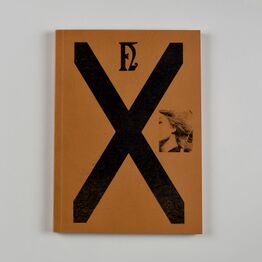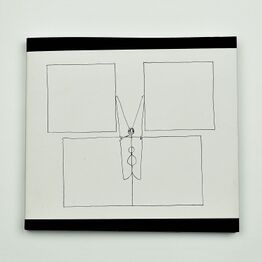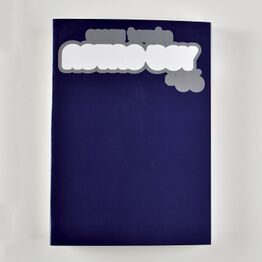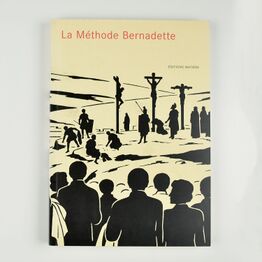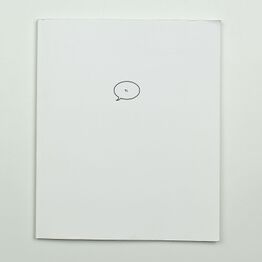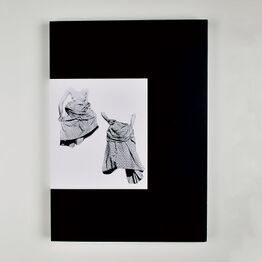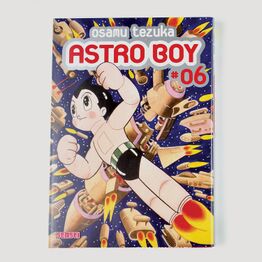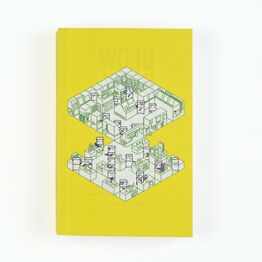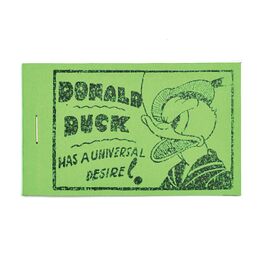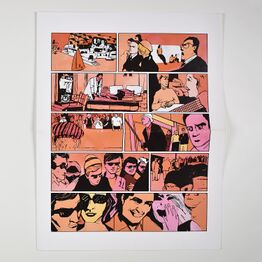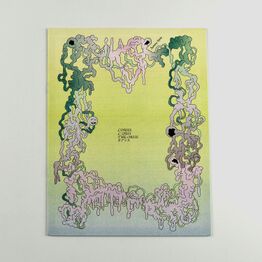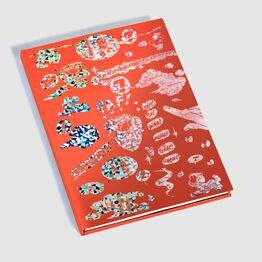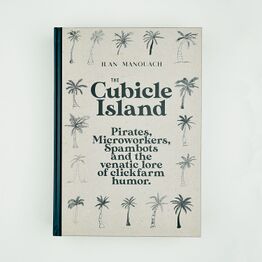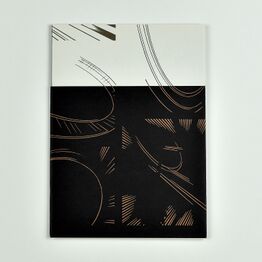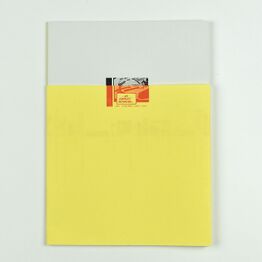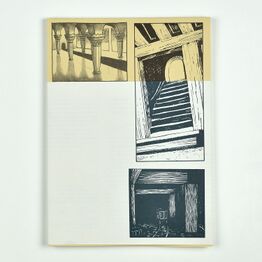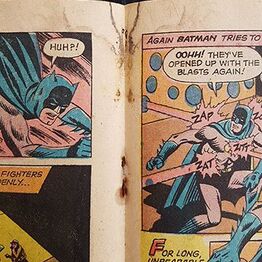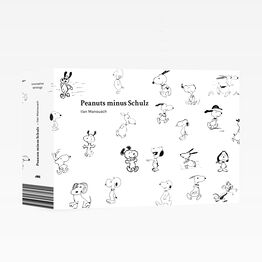Difference between revisions of "Conceptual comics"
| (7 intermediate revisions by 2 users not shown) | |||
| Line 1: | Line 1: | ||
| − | + | <gallery mode=packed heights=175px style="font-size:110%; font-weight:bold;"> | |
| − | ' | + | Luoyang_Zou_Rude_1999.jpg|link=#Rude |
| + | Tamburini_Stefano_Snake_Agent_2005.jpg|link=#Snake Agent | ||
| + | Ruiz_Francesc_Wasim_1995_2014.jpg|link=#Wasim 1995 | ||
| + | Manouach_Ilan_Tintin_Akei_Kongo_2015.jpg|link=#Tintin Akei Kongo | ||
| + | Fossoul_Nikita_Goblet_Dominique_Chronographie_2010.jpg|link=#Chronographie | ||
| + | Hetamoe_Muji_Life_Yangire_Yandere_2015.jpg|link=#Muji Life & Yangire/Yandere | ||
| + | Sikoryak_R_Terms_and_Conditions_2017.jpg|link=#Terms and Conditions | ||
| + | Matthey_Pascal_978_2014.jpg|link=#978 | ||
| + | Un_Faulduo_La_historieta_en_el_Faulduo_mundo_moderno_2015.jpg|link=#La historieta en el (Faulduo) mundo moderno | ||
| + | Joubert_Bernard_Polyepoxy_2017.jpg|link=#Polyepoxy | ||
| + | Vitaliti_Martin_360_2016.jpg|link=#360º | ||
| + | Beauclair_Alexis_Photon_2014.jpg|link=#Photon | ||
| + | Puigros-Puigener_Jerome_Compte-rendu_meteorologique_2013.jpg|link=#Compte-rendu des conditions météorologiques | ||
| + | CCCCC_Negros_Rojos_2017.jpg|link=#Negros Rojos | ||
| + | Craghead_III_Warren_How_To_Be_Everywhere_2007.jpg|link=#How to be Everywhere | ||
| + | Hagelberg_Matti_Ala-Harja_Riikka_Rakennusohje_2012.jpg|link=#Rakennusohje | ||
| + | Graham_VA_Eisenhower_JA_Scaffold_I-XLIV_2012-2015.jpg|link=#Scaffold | ||
| + | Henninger_Francois_RIP_2017.jpg|link=#RIP | ||
| + | Manouach_Ilan_Noirs_2014.jpg|link=#Noirs | ||
| + | Ruiz_Francesc_Comics_Meetings_Artists_Books_2013.jpg|link=#Comics Meetings Artist's Books | ||
| + | Ruiz Francesc A Selection of Queer Rage Comics 2019.jpg|link=#A Selection of Queer Rage Comics | ||
| + | Chak_Tings_Undocumented_The_Architecture_of_Migrant_Detention_2017.jpg|link=#Undocumented: The Architecture of Migrant Detention | ||
| + | Samplerman_Miscomocs_Comics_2017.jpg|link=#Miscomocs Comics | ||
| + | Gerner_Jochen_Grande_Vitesse_2009.jpg|link=#Grande Vitesse | ||
| + | Puigros-Puijener_Jerome_384_2010.jpg|link=#384 | ||
| + | Puigros-Puijener_Jerome_Gone_with_the_Wings_2010.jpg|link=#Gone with the Wings | ||
| + | Lil Buddies Magazine 1 2013.jpg|link=#Lil' Buddies Magazine | ||
| + | Ruiz Francesc Comics de la Revolucion 2008.jpg|link=#Cómics de la Revolución | ||
| + | Baers_Michael_Selected_Work_for_Publications_2005-2010_2010.jpg|link=#Selected Work for Publications 2005-2010 | ||
| + | Newgarden Mark We All Die Alone 2005.jpg|link=#We All Die Alone | ||
| + | Pichler_Michalis_Klassiker_des_Horrorfilms.jpg|link=#Klassiker des Horrorfilms | ||
| + | Pinard_Guillaume_Tomate_2010.jpg|link=#Tomate | ||
| + | Utzni_Sebastian_M-Maybe_Human_Torch-Towering_Inferno_2019.jpg|link=#M-Maybe (Human Torch-Towering Inferno) | ||
| + | Suggestions_d_harmonies_FEMA_Home_Shelter.jpg|link=#Suggestions d'harmonies | ||
| + | Foley_Tate_Lost_Works_by_Ed_Ruscha_After_Martin_Lang_2018.jpg|link=#Lost: Works by Ed Ruscha (After Martin Lang) | ||
| + | Val_Gesto_Yannick_Bomba_Massimiliano_Sadler_Leon_Euroboys_Crysis_2012.jpg|link=#Euroboys Crysis | ||
| + | ACT_ESOL_Language_Resistance_Theatre_2016.jpg|link=#ACT ESOL Language, Resistance, Theatre | ||
| + | Rojare_Francoise_Mnemopolis_D_apres_Maurice_Roche_2016.jpg|link=#Mnémopolis (d’après Maurice Roche) | ||
| + | Appel_Rosaire_Perturbations_2019.jpg|link=#Perturbations | ||
| + | Balcaen_Alexandre_Manifeste_2016.jpg|link=#Manifeste | ||
| + | Valente Andre Mi Propio Macanudismo 2017.jpg|link=#Mi Propio Macanudismo | ||
| + | Appel Rosaire Intersections 2017.jpg|link=#Intersections | ||
| + | Lebrun_Olivier_A_Final_Companion_to_Books_from_the_Simpsons_new_ed_2018.jpg|link=#A Final Companion to Books from the Simpsons | ||
| + | Black_Panther_Coloring_Book.jpg|link=#Black Panther Coloring Book | ||
| + | Wylesol George House 2017.jpg|link=#House | ||
| + | Cordel Urbano 1 1973.jpg|link=#Cordel Urbano | ||
| + | Ruiz Francesc Il Fumetto dei Giardini 2015.jpg|link=#Il Fumetto dei Giardini | ||
| + | Casteels_Michael_E_Lazing_West_No_1_2017.jpg|link=#Lazing West No 1 | ||
| + | Habeascorpus_Les_Romans_Graphiques_2019.jpg|link=#Les Romans Graphiques | ||
| + | Largier_Loic_Obscurcite_2017.jpg|link=#Obscurcité | ||
| + | Gerner Jochen Panorama du feu 2010.jpg|link=#Panorama du Feu | ||
| + | Aranguri Luis Remake 2015.jpg|link=#Remake | ||
| + | Stein Sammy Retour vers le centre 2015.jpg|link=#Retour vers le centre | ||
| + | Vachey Michel Trous gris 2017.jpg|link=#Trous gris | ||
| + | Ruiz Francesc The Street 2017.jpg|link=#The Street | ||
| + | Mars LL de Communes du livre 2017.jpg|link=#Communes du livre | ||
| + | Luna Raul 1000X 2018.jpg|link=#1000X | ||
| + | Chailleux Guillaume Filer 2019.jpg|link=#Filer | ||
| + | Garrido Corentin Astro Boy 06 2020.jpg|link=#Astro Boy 06 | ||
| + | Bruel Laurent soeurs Bernadette La Methode Bernadette 2008.jpg|link=#La Méthode Bernadette | ||
| + | Illiterature 5 The Graphic Novel 2015.jpg|link=#Illiterature | ||
| + | Gerner Jochen TNT en Amerique 2002.jpg|link=#TNT en Amérique | ||
| + | Varlez Robert Suites 2016.jpg|link=#Suit(es) | ||
| + | Manouach Ilan La Ballade de la Mer Salee 2020.jpg|link=#La ballade de la mer salée | ||
| + | Henne William Lowenthal Xavier Astro Boy 06 2020.jpg|link=#Astro Boy 6 | ||
| + | Manuel_Au_Travail_Blow_Book_2019.jpg|link=#Au Travail | ||
| + | Ruiz_Francesc_Donald_Duck_has_a_Universal_Desire.jpg|link=#Donald Duck Has a Universal Desire | ||
| + | Ruiz_Francesc_Fahrenheit_451s_Comic_2016.jpg|link=#Fahrenheit 451's Comic | ||
| + | Ruppert_et_Mulot_Le_Royaume_2011.jpg|link=#Le Royaume | ||
| + | Muhr_Felipe_Codex_2018.jpg|link=#Codex | ||
| + | Stein Sammy The Oasis 2019.jpg|link=#The Oasis | ||
| + | Manouach_Ilan_Abrege_de_Bande_Dessinee_Francobelge_2018.jpg|link=#Compendium of Francobelgian Comics | ||
| + | Manouach Ilan The Cubicle Island 2020.jpg|link=#The Cubicle Island | ||
| + | Vitaliti_Martin_Lineas_Cineticas_2009.jpg|link=#Líneas Cinéticas | ||
| + | Vitaliti_Martin_Didascalias_2013.jpg|link=#Didascalias | ||
| + | Vitaliti_Martin_Fondos_2013.jpg|link=#Fondos | ||
| + | Chuquet_Ines.jpg|link=#Untitled | ||
| + | Manouach_Ilan_Peanuts_Minus_Schulz.jpg|link=#Peanuts minus Schulz | ||
| + | </gallery> | ||
| − | The works of this collection | + | ==Introduction== |
| + | |||
| + | '''Conceptual Comics [ CoCo ]''' presents works that diverge from established conventions of comics as a medium. This library is a resonating chamber for conceptual works and unconventional practices little known outside their communities and also a springboard for establishing the conditions for affective lineages among similarly minded practitioners. The variety of the collected CoCo material expresses the editors' preference for non-uniform consistency, making a room for a perpetual becoming of the medium. Nevertheless, CoCo works share many issues and urgencies, alternating between material self-reflexivity and critical exhaustion. They operate on the margins of distribution and reception and their unrootedness in the medium's spectrum is more than an abstraction: artists uncomfortable with entrenched roles invite readers, in the absence of critical discourse, to engage with the works in non-specified, at times forensic ways of examination. I argue that this condition, more than a minor drawback of a normative industry, induces new behaviours and forms of social relationships. Every CoCo work featured in this collection explores the very substrate of its medium not as a culturally neutral site, but as a way to build alternative histories, replete with its own material properties and signifying potentials. | ||
| + | |||
| + | This collection proposes to examine how social and economic forces and their established commercial and communication routines affect the medium’s meaning and signification. The rainforest of pulp production, the printer’s studio, the readers’ column and the landfill do not simply represent geographies of comics industry but are technologies of inscription in their own right. They are integral elements of a material language that actively shapes comics and challenges the reader to negotiate meaning through different distributions of transparency in its products. This collection proposes to equally embrace real, unclaimed, anticipated and fictional practices in their perpetual materialisation, and reflect on their specific sites of production and on their potential to register meaning and organise discourse based on inscriptions of this material language. | ||
''Ilan Manouach'' | ''Ilan Manouach'' | ||
| + | |||
| + | ''First published on 28 April 2019 with 20 featured works. An expanded version featuring 77 works published on 10 October 2020.'' | ||
==Rude== | ==Rude== | ||
| Line 233: | Line 317: | ||
==Fondos== | ==Fondos== | ||
<div style="overflow: auto; width: 100%">{{:Fondos}}</div> | <div style="overflow: auto; width: 100%">{{:Fondos}}</div> | ||
| + | |||
| + | ==Untitled== | ||
| + | <div style="overflow: auto; width: 100%">{{:Inès Chuquet}}</div> | ||
| + | |||
| + | ==Peanuts minus Schulz== | ||
| + | <div style="overflow: auto; width: 100%">{{:Peanuts_Minus_Schulz}}</div> | ||
==Credits== | ==Credits== | ||
| Line 241: | Line 331: | ||
{{Literature}} | {{Literature}} | ||
| + | __NOTOC__ | ||
Revision as of 14:42, 9 December 2022
Introduction
Conceptual Comics [ CoCo ] presents works that diverge from established conventions of comics as a medium. This library is a resonating chamber for conceptual works and unconventional practices little known outside their communities and also a springboard for establishing the conditions for affective lineages among similarly minded practitioners. The variety of the collected CoCo material expresses the editors' preference for non-uniform consistency, making a room for a perpetual becoming of the medium. Nevertheless, CoCo works share many issues and urgencies, alternating between material self-reflexivity and critical exhaustion. They operate on the margins of distribution and reception and their unrootedness in the medium's spectrum is more than an abstraction: artists uncomfortable with entrenched roles invite readers, in the absence of critical discourse, to engage with the works in non-specified, at times forensic ways of examination. I argue that this condition, more than a minor drawback of a normative industry, induces new behaviours and forms of social relationships. Every CoCo work featured in this collection explores the very substrate of its medium not as a culturally neutral site, but as a way to build alternative histories, replete with its own material properties and signifying potentials.
This collection proposes to examine how social and economic forces and their established commercial and communication routines affect the medium’s meaning and signification. The rainforest of pulp production, the printer’s studio, the readers’ column and the landfill do not simply represent geographies of comics industry but are technologies of inscription in their own right. They are integral elements of a material language that actively shapes comics and challenges the reader to negotiate meaning through different distributions of transparency in its products. This collection proposes to equally embrace real, unclaimed, anticipated and fictional practices in their perpetual materialisation, and reflect on their specific sites of production and on their potential to register meaning and organise discourse based on inscriptions of this material language.
Ilan Manouach
First published on 28 April 2019 with 20 featured works. An expanded version featuring 77 works published on 10 October 2020.
Rude
 | |
| Author | Zou Luoyang |
|---|---|
| Language | English |
| Publisher | self-published (free) |
| City | Hong Kong |
| Date | 1999 |
| Format | 21 x 14.85 cm |
| Fabrication | Risograph |
| E-book | Not available |
In 1998, Zou Luoyang, chief-editor of the risographed art zine Rude, controversially declared: “The future of comics is in the trash can.” Fifteen years later, he addressed a consortium of publishing representatives at the San Diego Comic-Con, with the following words: “It is a measure of your progress in regards to the ethics of the comic book industry the last ten years, that my 1998 remark no longer raises any eyebrows. You are filling the shipping containers, trash cans, landfill dumps and incinerators with literally tons of paper pulp: newsstand magazines, graphic novels, comic pamphlets, satirical magazines, promotional giveaways and funny papers, superhero novelettes, shonen manga anthologies, comic weeklies sealed in protective polyurethane bags, anniversary collectors slipcase editions–and now, slender box sets of colour volumes of serialized fiction. The happy day has arrived when nobody any longer considers comics too good to throw away. The social shift had been successful, and disposability is now naturalised, partly thanks to you, the comics industry.”
Luoyang was familiar with discard studies that analyse in detail what disposable components say about our relationship with the world and the manifold ways social and economic values are reflected in what is thrown away. He even went on to propose an extensive, now quasi-forgotten comics-manifesto on the energising potential of trash, bringing in observations of a nascent branch of social sciences, rudology (from the Latin rudus: waste). Understanding the very nature of rubbish, Luoyang found in comics the embodiment of trash, a trash that you can not just dispose of (both in the sense of throw away and settle a matter), but a trash that you have to read through and confront as it is. Luoyang allegedly found in a dumpster Michael Thompson’s book Rubbish Theory: The Creation and Destruction of Value, a reading that specified his practice and reoriented his approach to distribution. In the book, Thompson proposes that for a human-made object to go from something everyday and transient to something of great, durable value, it must first become rubbish. He looks not specifically at comics, but antiques, real estate, and dated kitsch to make the argument that something can not move from the worthless to the valued without first transitioning to waste with a cultural or social value of zero.
It was clear that Luoyang's interest in disposability was not about personally reaching into new processes and spaces in search of profit. Bitter about the industry's indifference to his ideas, Luoyang was committed to retaliate against the opposite end of the professionals, defending this time the unabashed self-indulgence of the contemporary reader. In a personal exchange, ruminating over the Readers' (his own capitalization and pluralization) existential aporias, he adds, appropriately quoting Bataille at length: “Authors are 'slaves working like cowards to prepare the beautiful blustering eruptions that alone are capable of answering the needs that torment the bowels of most men.' Readers, on the other hand, obey a much simpler economy: they absorb and excrete and there is no doubt on which end I will bet for empowerment.” Luoyang, after years of careful examination and methods of industrial espionage, embraced a design for Rude, based entirely on planned obsolescence, the industry's way to artificially limit the use life of an object, favouring the shortening of replacement cycles.
Risographed on cheap non-archival, non-acid-free newsprint, Rude with its modest print run of 200 (signed) copies, contributed its minor share to the landfills. Originally disseminated in landfills with its delicate copies covered under tonnes of debris, Luoyang invited readers to search for it by practising targeted digging, and other methods at the margins of grassroots archaeology. Zou Luoyang’s project can be understood as an exercise in accelerating a book’s life cycle, displacing the reader from his comfort zone to a participatory psychogeographic exploration of suburban dumping grounds. Rude, more than a pungent comment on how human labour, (and here Luoyang will have unequivocally referred to the comics industry) always turns to waste, stratified in multiple temporal scales, waiting to be managed towards efficient disintegration, has the merit to acknowledge the energising potential of trash. Rather than defining the benign side of disintegrating matter, for example, biological waste containing macronutrients for land fertilisation, Luoyang claims for an unapologetic cultural production of toxicity.
Snake Agent
 | |
| Author | Stefano Tamburini |
|---|---|
| Language | Italian |
| Publisher | Coniglio (14€) |
| City | Rome |
| Date | 2005 |
| Pages | 48 |
| Format | 26.5 cm x 21.5 cm |
| Fabrication | Offset |
| ISBN | 978-8-8888337-8-1 |
| E-book | PDF (37 mb) |
Snake Agent is a re-edition from Coniglio Press of Stefano Tamburini's series. Originally published in the magazine Frigidaire from 1980 to 1984, Snake Agent is a détournement from Mel Graff's Secret Agent X-9 comics strip from the 1940s. It explores the uses of Xerox technologies, and more precisely the newly introduced portable model Xerox 3107 in regards to comics making. Beyond mere duplication, Tamburini is little concerned by Xerox's claims of quality and excellence of reproduction. He is more interested in the machine's portability and ease of manipulation; he uses the photocopier as an expressive tool, and by moving the pages on the machine's flatbed, he stretches, distorts and disfigures Graff's characters. His use of the 3107 prefigures a generation of comics artists exploring the materiality of reproduction technologies and foregrounds the contextual opacity of one of comics craft's most inglorious processes; Tamburini's work, despite its obstructive materiality, makes xeroxing the object of the systematic and sustained attention that it deserves.
Wasim 1995
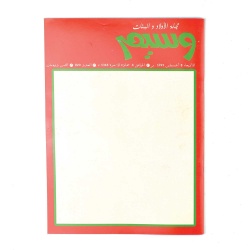 | |
| Author | Francesc Ruiz |
|---|---|
| Language | Arabic |
| Publisher | self-published (free) |
| City | Barcelona |
| Date | 2014 |
| Pages | 32 |
| Format | 29.7 cm x 21 cm |
| Fabrication | Offset |
| E-book | PDF (33 mb) |
In collaboration with Salah Malouli, Wasim 1995 was presented as an installation in MACBA's exhibition Justo delante de nosotros, Otras cartografías del Rif. Its printed version is a collection of thirty-two covers and has all the likes of a children's magazine in Arabic. The covers represent different moments from Morocco's recent history, commemorations and events from the official and religious calendars, such as the Ramadan, the Green March and celebrations of Pan-Arabism, as well as announcements of international contemporary events such as the Mexico Mundial. Although comics and children's literature press coming from France or Belgium were widely read and distributed circa 2005 in Morocco, there was no official or national equivalent to them. By pointing to this little known historical fact and drawing its inspiration from its Franco-Belgian counterparts, Wasim 1995 is a speculative exercise in what Moroccan children’s literature would look like. Ruiz walks a contentious line in mimicking the very violence of capital's market segmentation for the young public and with a sensitive eye, both estranges and provincializes what is taken for granted in western children’s literature.
Commentary: Juan Canela (South as a State of Mind, 2015, EN, [1]).
Tintin Akei Kongo
 | |
| Author | Ilan Manouach |
|---|---|
| Language | Lingala |
| Publisher | MMMNNNRRRG, La Cinquième Couche (40€) |
| City | Lisbon, Brussels |
| Date | 2015 |
| Pages | 64 |
| Format | 22 cm x 16.5 cm |
| Fabrication | Offset |
| E-book | PDF (20 mb) |
"Tintin Akei Kongo is the translated version of Tintin au Congo in Lingala, the official Congolese dialect. The book is an exact facsimile of the commercial edition and follows the industrial standards and layout of classical comics. The goal of this endeavor was not simply to construe the artist’s tasks through a redefinition of the possible interventions by commissioning a translation himself; neither to emphasize the importance of discursivity and self-referentiality as a way to address comics both as a language and a form of logic. The goal is neither to fill a historical error by making this work accessible in the language of those who are primarily interested, the oppressed, the insulted. One should never forget the implicit consensus that stands behind the choice of languages for translated works. The fact that the original edition hasn’t found its way to the African market with a Congolese edition, reminds the reader of Tintin Akei Kongo that distribution of cultural products is not solely governed by profit and market values. Adding Lingala to the 112 different translations of the Tintin Empire, Tintin Akei Kongo reveals blind spots in the expansion of the publishing conglomerates." (from publisher)
Commentary: Dan Nadel (The Comics Journal, 2015, EN), Le dernier des blogs (2015, FR), martalanca (Dá fala, 2015, PT), Uma Bedeteca Anónima (2015, ES), Bill Kartalopoulos (World Literature Today, 2016, EN).
Chronographie
 | |
| Authors | Nikita Fossoul, Dominique Goblet |
|---|---|
| Language | French, English (Introduction & Afterword) |
| Publisher | L'Association (59.75€) |
| City | Paris |
| Date | 2010 |
| Pages | 560 |
| Format | 25.6 cm x 19.6 cm |
| Fabrication | Offset |
| ISBN | 978-2-84414-387-7 |
| E-book | PDF (522 mb) |
Chronographie began with a simple idea: comics artist Dominique Goblet spontaneously proposes to her daughter Nikita Fossoul, then 7, to sit, face to face with her and make portraits of each other. They agree to regularly repeat the experience. This ritual is reproduced almost weekly, and for ten subsequent years. The book, released in the catalogue of L'Association presents a huge body work that chronologically registers the physical and artistic transformations of the two women. Chronographie is a durational performance unfolding entirely in the privacy of the domestic space; its encompassing time span stretching far from what is customary in autobiographical or other works of graphic literature, delivers a narrative of solidarity and care but also a rare glimpse into the process and development of artistic craftsmanship.
Video interview (Fnac, 6 min, 2011, FR).
Reviews: Jessie Bi (du9, 2010, FR), Domingos Isabelinho (The Hooded Utilitarian, 2010, EN), Pilau Daures (du9, 2013, FR).
Muji Life & Yangire/Yandere
 | |
| Author | Hetamoé |
|---|---|
| Language | English |
| Publisher | self-published (Clube do Inferno) (out of stock) |
| City | Lisbon |
| Date | 2015 |
| Pages | 24, 24 |
| Format | 19 cm x 19 cm, 19 cm x 14.5 cm |
| Fabrication | Risograph, B/W laser printing |
| E-book | PDF (21 mb) |
"Muji Life + Yangire/Yandere is a theoretical-practical zine comprising a comic and an essay (respectively), both engaging with the Japanese concepts of yandere (love-struck and psycho) and yangire (cute and psycho). Parodying the look and dimensions of Muji’s catalogue – the Japanese seller of household supplies whose Bauhaus-style minimalism is iconic of an ideal domestic order – Muji Life addresses the underlying connection between madness and method, violence and mundanity, through the eyes of a bloodthirsty “psychotic girl”. Its counterpart, Yangire/Yandere, explores the meaning and (ideological, political) ambivalence of yandere and yangire characters in anime, games and popular culture, including Mirai Nikki, Elfen Lied, Higurashi no Naku Koro ni, Lucky Star, Yandere Simulator and the Sada Abe Incident." (from author)
Terms and Conditions
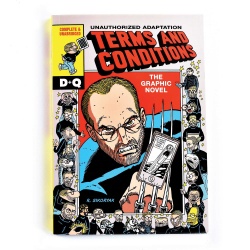 | |
| Author | R. Sikoryak |
|---|---|
| Language | English |
| Publisher | Drawn & Quarterly ($14.95) |
| City | New York |
| Date | 2017 |
| Pages | 108 |
| Format | 17 cm x 24.3 cm |
| Fabrication | Offset |
| ISBN | 978-1-77046-274-8 |
| E-book | PDF (123 mb) |
"For his newest project, Sikoryak tackles the monstrously and infamously dense legal document, iTunes Terms and Conditions, the contract everyone agrees to but no one reads. In a word for word 94-page adaptation, Sikoryak hilariously turns the agreement on its head – each page features an avatar of Apple cofounder and legendary visionary Steve Jobs juxtaposed with a different classic strip such as Mort Walker’s Beatle Bailey, or a contemporary graphic novel such as Craig Thompson’s Blankets or Marjane Satrapi’s Persepolis. Adapting the legalese of the iTunes Terms and Conditions into another medium seems like an unfathomable undertaking, yet Sikoryak creates a surprisingly readable document, far different from its original, purely textual incarnation and thus proving the accessibility and flexibility of comics. When Sikoryak parodies Kate Beaton’s Hark A Vagrant peasant comics with Steve Jobs discussing objectionable material or Homer Simpson as Steve Jobs warning of the penalties of copyright infringement, Terms and Conditions serves as a surreal record of our modern digital age where technology competes with enduringly ironclad mediums." (from publisher)
Reviews: David Barnett (The Independent, 2017, EN), Joe Coscarelli (The New York Times, 2017, EN).
Commentaries: Matt Kamen (Wired, 2017, EN), TCP Staff (Vice, 2017, EN).
978
 | |
| Author | Pascal Matthey |
|---|---|
| Language | French |
| Publisher | La Cinquième Couche (16€) |
| City | Brussels |
| Date | 2013 |
| Pages | 48 |
| Format | 20 cm x 29 cm |
| Fabrication | Offset |
| ISBN | 978-2-9303569-4-5 |
| E-book | PDF (52 mb) |
Matthey works a day job in a Brussels bookstore and judging from his surprising body of work as a comics artist, he is already at ease with more conventional forms of graphic narrative. This book, whose title comes from a prefix that designates, in the numeric ISBN system, the category of objects assigned as books, prefigures something different. 978 took ten years to ferment. It's a narrative work exclusively composed from promotional material circulating in Matthey's workplace that advertises new arrivals of mainstream and epic fantasy comics literature. For many years he collected these pamphlets and painstakingly created a new non-representational, grid-based collage, where each page embodies a different mood. Matthey's selective focus on the physical aspects of the comics industry (its underutilized resources) and the non-remunerative value of its paratextual economy, makes this book the ultimate redemption. 978 is a book "with the sound of its own making", a psychedelic trip that emerges through the interplay between work and leisure, text and context, and writer and reader/user/librarian sensibilities.
Reviews: Jean-Charles Andrieu de Levis (du9, 2014, FR), Pedro Moura (du9, 2014, EN), Pedro Moura (du9, 2014, FR).
La historieta en el (Faulduo) mundo moderno
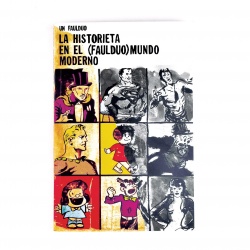 | |
| Author | Un Faulduo |
|---|---|
| Language | Spanish |
| Publisher | Tren en Movimiento (AR$ 490,00) |
| City | Buenos Aires |
| Date | 2015 |
| Pages | 160 |
| Format | 16 cm x 23 cm |
| Fabrication | Offset |
| ISBN | 978-987-3789-10-6 |
| E-book | PDF (72 mb) |
Hailing from Buenos Aires, Un Faulduo is an artists collective which has been investigating, through publications, scholar presentations and performative interventions the different articulations of comics and graphic literature. Here, they revisit Oscar Masotta's legendary research book La historieta en el mundo moderno, originally published in 1970. Masotta's published research on North-American, European and Argentinian comics, as well as the First World Comics Biennial he directed in 1968, were seminal in the medium's history for treating comics as an art form in its own right. Un Faulduo using scans of a rare copy of Masotta's book, recompose the texts with collages, redraw illustrations and materially intervene on Masotta's text. This is a rare example of artistic research in comics, a praxeology proposing to further blur the boundaries between theory and practice. La historieta en el (Faulduo) mundo moderno could be understood as an exercise in perlaboration: a process in psychoanalysis that consists of recognizing and overcoming the resistances (here of the increasingly globalised dimensions of artistic resonance in comics practice) through the repetition, the elaboration and the amplification of an interpretation, that would have certainly appealed to Masotta's inclination for psychoanalysis.
Reviews: Palabras amarillas (2015, ES), Mariano Kairuz (Página12, 2016, ES).
Polyepoxy
 | |
| Author | Bernard Joubert |
|---|---|
| Language | French |
| Publisher | Fondation Paul Cuvelier (16€) |
| City | Brussels |
| Date | 2017 |
| Pages | 92 |
| Format | 17.2 cm x 11 cm |
| Fabrication | Offset, paperback |
| E-book | PDF (24 mb) |
Discussed in the pages of the influential comics reader Eprouvette n° 1 (2006), Polyepoxy, published by the Foundation Paul Cuvelier in Brussels, explores "the most plagiarized comic panel": the manifold unsolicited iterations of a drawing from Cuvelier's Epoxy (1968) depicting a naked Olympia looking behind her shoulder. Bernard Joubert literally leafed through thousands of magazines to document the exact same pose in more than 40 different drawings, particularly in the productions of Italian erotic fumetti, but also elsewhere. Polyepoxy's aesthetics are forensic, with a feel that would have appealed to Lev Manovich's analysis of cultural data or to Franco Moretti's distant reading: the publishers of the book took care to title and date the different findings from the cheaply printed trade paperbacks and reproduce the fragments in the exact size they had been printed. Polyepoxy demonstrates the self-reflexivity of the comic medium and how pervasive swiping practices are in the just-in-time production standards of its economy. It also reflects on how graphic objects move across time and activate different semantic networks only to ultimately confirm the highly gendered nature of the industry's imagination.
360º
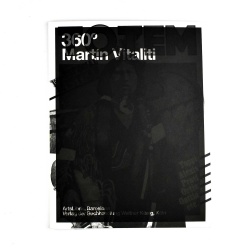 | |
| Author | Martín Vitaliti |
|---|---|
| Language | Spanish (Editor's Note also Catalan/English) |
| Publisher | ArtsLibris (20€) |
| City | Barcelona |
| Date | 2016 |
| Pages | 40 |
| Format | 27 x 21 cm |
| Fabrication | Offset, paperback |
| ISBN | 978-3-86335-943-0 |
| E-book | PDF (36 mb) |
"One could call the artist’s book 360º by Martín Vitaliti (Buenos Aires, 1978, lives in Barcelona) a concept-comic. It is based on a single page from La Banda del Missouri [The Missouri Gang] designed by the acknowledged Italian Hugo Pratt (published in TOTEM EXTRA 20. Especial Western, Editorial Nueva Frontera, Madrid, 1978, p. 91). Its grid of thirteen panels has been reproduced forty-one times while the respective illustrations have been “expanded” by Vitaliti. This results in thirteen panoramic views of each scene throughout the book. The narrative as such — Indians and rangers discovering a riderless horse and a dead body floating in the Missouri river — hasn’t an important meaning. What becomes meaningful is the void of the vast landscape that is developed by Vitaliti’s intervention. He evokes a strange kind of “something in between”, on one hand a visual cinematic effect; on the other hand a frozen storyboard. Compared with other famous panoramic representations of landscapes — think for instance of the Panorama of San Francisco from California Street Hill (1877) by Eadweard Muybridge, or Every Building on the Sunset Strip (1966) by Ed Ruscha — Vitaliti’s approach appears highly complex. What might look as a popular comic book, turned into a Cadavre Exquis, an existing story narrated anew by someone else, that doesn’t develop to a climax but instead remains on hold." (from the editor's note)
Photon
 | |
| Author | Alexis Beauclair |
|---|---|
| Language | French, English |
| Publisher | self-published (Papier Machine) (8€, sold out) |
| City | Saint-Férreol-Trente-Pas |
| Date | 2014 |
| Pages | 8 |
| Format | 18 cm x 26 cm |
| Fabrication | Risograph |
| E-book | PDF (16 mb) |
As described on Beauclair's website, Photon is a narrative experience where the reader enters the optical apparatus through a variety of filters and prisms. Once the end is reached, the reader flips the book only to do the reading in the other direction, and much like a photon she travels back in time. Photon is a beautifully printed visual poem that highlights time and the reading experience as relative quantities.
Compte-rendu des conditions météorologiques
 | |
| Author | Jérôme Puigros-Puigener |
|---|---|
| Language | French |
| Publisher | Habeas Corpus (6€) |
| City | Brussels |
| Date | 2013 |
| Pages | 26 |
| Format | 21 cm x 29.7 cm |
| Fabrication | Xerox, Japanese-style binding |
| E-book | PDF (30 mb) |
Following the practices of conceptual art, the title explicitly mentions the programmatic nature of this work. For two years, Puigros-Puijener observed and registered the weather on a daily basis in the city of Brussels where he lives and, drawing on a weather forecast website, compared it to two different cities for each month such as Alice Springs (Australia) or Biarritz (France). Using weather forecast graphics, a vernacular system of pictogrammatic representation, Puigros-Puijener's work brings to mind Cage's desire to have his music sound like the weather, only here in its digital, mediated, infographic variant.
Negros Rojos
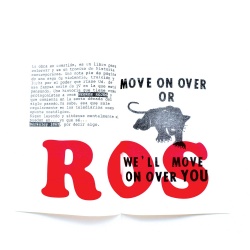 | |
| Author | CCCCC |
|---|---|
| Language | Spanish |
| Publisher | self-published (Fatbottom Books) (10€, out of stock) |
| City | Barcelona |
| Date | 2017 |
| Pages | 21 |
| Format | 25 cm x 34 cm |
| Fabrication | Silkscreen printing |
| E-book | PDF (23 mb) |
CCCCC mocking Barcelona's CCCB's and the institutional acronymic nomenclature, stands for Center for Communication and Conservation of Contemporary Comics. "The work in question is a coloring book, a piece of contemporary history. It's a footnote of a saga of violence, betrayal and fight for the power that you usually laugh at when watching famous TV series. It's a history that started in the sixties...". This is from the introductory text from Negros Rojos; a collection of twenty-one silkscreened posters sealed in an envelope. The project has been presented as a show, and according to CCCCC's spokesperson, "in one of the smallest exhibition spaces in comics history, the bookstore Fat Bottom in Barcelona, further divided by a median wall that could only allow a couple of simultaneous visitors, at most". Negros Rojos presents the findings of a document that was supposedly produced by the Black Panthers for the indoctrination of the young. In reality, it was designed by FBI's Counter Intelligence Program in order to discredit the Black Panthers and mock their revolutionary agenda. Comics has been widely used for propaganda and Negros Rojos traces the bitter history of a comics coloring book that foregrounded the uses of cultural appropriation, overidentification and indoctrination, revealing them as the comics medium's most powerful modes of address.
How to be Everywhere
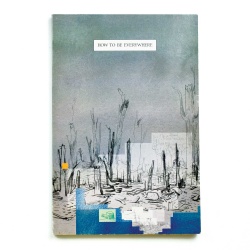 | |
| Author | Warren Craghead III |
|---|---|
| Language | English |
| Publisher | self-published (15€) |
| City | Charlottesville, VA |
| Date | 2007 |
| Pages | 90 |
| Format | 15.2 cm x 23 cm |
| Fabrication | Digital printing |
| E-book | PDF (19 mb) |
How to be Everywhere draws its inspiration from Apollinaire's Calligrames: a literary work that emphasized a playful use of typography and layout as meaningful signifiers in their own right (they would prefigure the more fully experimentations of concrete poetry and poema processo in the 1950s). How to be Everywhere is a highly abstract narrative work that formally explores the interstices between comics and poetry through its elliptical, fragmented and object-oriented storytelling. Evincing all the formal elements that conventionally account for comics making such as panels, speech balloons, characters, genre tropes and other medial modes of address, Craghead's compositions claim - both graphically and in their storytelling structure - a narrative space where text and images are just substructures of the same language.
Rakennusohje
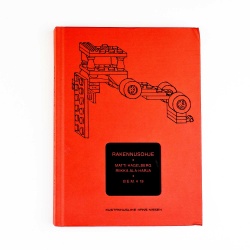 | |
| Authors | Matti Hagelberg, Riikka Ala-Harja |
|---|---|
| Language | Finnish |
| Publisher | Kustannusliike Hans Nissen (25€) |
| City | Lahti |
| Date | 2012 |
| Pages | 112 |
| Format | 15 cm x 20.5 cm |
| Fabrication | Offset, hardcover |
| ISBN | 978-9-52664-600-8 |
| E-book | PDF (84 mb) |
Matti Hagelberg, best known for his dexterity with the scratchboard technique and his ongoing saga Läskimooses, collaborates with writer Riikka Ala-Harja for the making of Rakennusohje. Ala-Harja’s narrative takes place in Normandy and unfolds through a series of disconnected events that can each be described with the conciseness of a title: "The daughter spends the week with her father. The woman visits an American cemetery. A cow gives birth. Eventually the daughter returns home, but she is distant. In the end the two women drive towards Finland. In the end there's a text about Rupert. A parachute mannequin made of cloth which was dropped from the plane during the invasion." Hagelberg's images are inspired by Lego user manuals with their diagrammatic displays that resemble narrative structures in comics grammar. The drawings have a piling effect and their interplay with the text brings in mind what Matthew Kirschenbaum calls rapid shuttling, a reading practice that oscillates between the quantitative display of information and the hermeunetic close reading of the prose.
Scaffold
 | |
| Authors | V. A. Graham, J. A. Eisenhower |
|---|---|
| Language | English |
| Publisher | self-published (Most Ancient) (15€) |
| City | Oakland, CA |
| Date | 2012-2015 |
| Pages | 48 |
| Format | 23.5 cm x 21.6 cm |
| Fabrication | Digital printing, silkscreen covers, handbound |
| E-book | PDF (62 mb) |
Graphically, Scaffold is a strange object. The pages of the series' books are entirely composed of different sets of quasi-architectural formations and various sets of unfolding landscapes mostly depicted frontally. The sequence follows an implicit, oulipian rule that the two artists agreed upon: no world location can ever be revisited or depicted again once it is left. They manifest the artists' desire to produce a system for conveying movement through sets of fixed structures where storytelling, consisting mostly in commonplace dialogues, is just a byproduct of these rigid superstructures. Scaffold reads like a post-human narrative; the reader is left to contemplate something similar to the sidescrolling of a platform video game. No main characters are present. No action takes place. Scaffold thematizes the narrative impact of the background layer. It is a demonstration of comics' intermedial referential capacities in regards to other media, here video games.
RIP
 | |
| Author | François Henninger |
|---|---|
| Language | French |
| Publisher | PCCBA (8€) |
| City | Paris |
| Date | 2017 |
| Pages | 48 |
| Format | 19.5 cm x 29.7 cm |
| Fabrication | Digital printing |
| E-book | PDF (69 mb) |
Henninger takes Alex Raymond's comics strip Rip Kirby for the material of his quasi-sculptural collage experiment. The 48 pages of his self-published RIP exclusively consist of one single page composition of Raymond's comics. Each reproduction of the page comes with paratextual annotations and registers an operation of collage. The pages are xeroxed and the collage operations slowly accumulate, allowing only a few of the recycled materials to carry on. RIP stages the resistance of a morphogenetic narrative to unfold despite the general entropic tendency to degenerate into abstract drawings.
Noirs
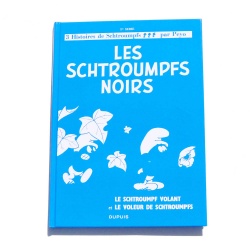 | |
| Author | Ilan Manouach |
|---|---|
| Language | French |
| Publisher | La Cinquième Couche (10€, out of stock) |
| City | Brussels |
| Date | 2014 |
| Pages | 64 |
| Format | 21 cm x 29.7 cm |
| Fabrication | Offset |
| E-book | PDF (13 mb) |
Noirs is a facsimile of the original edition of Les Schtroumpfs Noirs: same cover, same stories, same number of pages, same format, and as close to the original in the quality of paper, weight and so on. There is one, single difference: the four plates of magenta, yellow, cyan and black that form the basis of offset printing have been replaced by four plates of cyan. The goal of this endeavour, apart from reactivating an old consensus and problematizing the innocuously naturalization of the ideological potential of color, was also to shed light on the industrial fabrication of books. Offset printing, a supposedly transparent and mechanic process, once it stops working correctly (here, regarding color separation), can be thoroughly political.
Reviews: Pedro Moura (du9, 2014, EN), Pedro Moura (du9, 2014, FR).
Comics Meetings Artist's Books
 | |
| Author | Francesc Ruiz |
|---|---|
| Language | Spanish |
| Publisher | self-published (Fundació Joan i Pilar Miró a Palma) (free) |
| City | Palma de Mallorca |
| Date | 2013 |
| Pages | 32 |
| Format | 21 cm x 29.7 cm |
| Fabrication | Offset |
| E-book | PDF (43 mb) |
Comics Meetings Artist's Books is a visitor's account of a fictional book fair. Typical of Ruiz's strategy, the project was also presented as an installation at the Fundació Joan i Pilar Miró in Palma de Mallorca. By following the typical guide from illustrated educational literature, the reader gets to visit seven different stands of cutting edge producers of artist's books and independent comics, based in the Mediterranean area. Comics Meetings Artist's Books imagines a world situated at the periphery of the major comics industries (EU-US-JP), where geographical alliances can be activated towards the production of radical artistic scenes and communities. The proverbial figure of the guide is none other than Tiramolla, the famous Italian comics character created by Renzi and Rebuffi in the 1950s. Ruiz's choice for this comic character is not arbitrary. Tiramolla points to a time where the Non-Aligned Movement brought together 120 member-states to articulate an agenda that was independent from the two major political powers during the Cold War era. Comics Meetings Artist's Books, situated far from the medium's superpower geographies, traces an impossible history of comics alliances; the camp aesthetics and secret affinities of the cultural and geographical subaltern of experimental comics producers.
A Selection of Queer Rage Comics
 | |
| Author | Francesc Ruiz |
|---|---|
| Language | Spanish |
| Publisher | self-published (20€) |
| City | Barcelona |
| Date | 2019 |
| Pages | 28 |
| Format | 21 cm x 29.7 cm |
| Fabrication | Xerox |
| E-book | PDF (8 mb) |
Undocumented: The Architecture of Migrant Detention
 | |
| Author | Tings Chak |
|---|---|
| Text | Syed Hussan |
| Language | English |
| Publisher | Ad Astra Comix ($10-20) |
| Date | 2017 |
| Pages | 132 |
| Format | 17 cm x 24 cm |
| Fabrication | Offset |
| ISBN | 978-0-9940507-6-2 |
| E-book | PDF (38 mb) |
Using comics, interviews, and architectural sketches, Undocumented explores a growing industry in an era of militarised borders, state surveillance, and criminalized migration. Originally released in 2014 to an architectural audience, this special edition from Ad Astra Comix features an updated afterword by Syed Hussan (No One Is Illegal, Toronto), as well as an interview with a former detainee. Focusing on Canada's migrant detention system, where detainees are often held in maximum security prisons without charges for indefinite periods of time, Undocumented draws chilling conclusions about the societies that tolerate these punitive spaces of confinement. Proceeds from the sale of each book go to the End Immigration Detention Network. (from publisher)
Miscomocs Comics
 | |
| Author | Samplerman |
|---|---|
| Language | English |
| Publisher | Le dernier Cri (12€) |
| City | Marseille |
| Date | 2017 |
| Pages | 40 |
| Format | 16 cm x 24 cm |
| Fabrication | Offset trikro and quadri |
| E-book | PDF (68 mb) |
Inside the restless underground sphere, far from conventional and edicted ways, fanzine is often chosen as a way to express oneself. For some independent and/or alternative comic writers, being and working in the margin is not a plan B but a real choice. This outsider status is sometimes a chance to investigate their own creative area and there, fanzine becomes not only a way but THE way to do it.
This is where we find Yvan Guillo, questioning, for 25 years, the limits of his own field. Seeing his self-produced fanzines appeared in the 1990s and the many well-defined work he did since, we could be tempted to qualify his behavior as typical underground author. But, around 2010, his strong will and interest in comics as a full artistic (codified) language, made the difference. Creating a new project, the author was far from thinking the huge scope it would have. We can find the origins of his narrative explorations through the diversity of his inspirations. Not only comics of course but poetry, radio, abstraction and surrealism, which can explain his interest for inter-iconic gaps and non-linear narrative experiences. Using mainstream comics (mostly from the 1950s) as a material, Yvan Guillo/Samplerman generates a new hypnotic, fascinating, vibrant, experimental dimension. Patterns, cut-ups, iterations, blasting before your eyes, making you wonder about what «reality» means. The way he pushes the boundaries of narration is like an earthquake transcending, mutating comic art. More than a pictorial world you could and would easily get lost into, his avant-gardist work is a real sensorial experience. (from pierrefeuilleciseaux.com)
Grande Vitesse
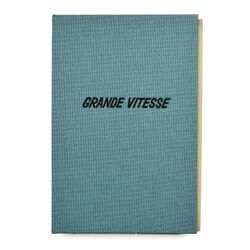 | |
| Author | Jochen Gerner |
|---|---|
| Language | French |
| Publisher | L'Association (30€) |
| City | Paris |
| Date | 2009 |
| Pages | 30 |
| Fabrication | Offset, hardcover |
| ISBN | 978-2-8441429-4-8 |
| E-book | PDF (42 mb) |
Railway drawing book.
384
 | |
| Author | Jérôme Puigros-Puigener |
|---|---|
| Language | French |
| Publisher | Habeas Corpus (4€) |
| City | Brussels |
| Date | 2010 |
| Pages | 16 |
| Format | 10.5 cm x 14.8 cm |
| Fabrication | Xerox, japanese-style binding |
| E-book | PDF (27 mb) |
Gone with the Wings
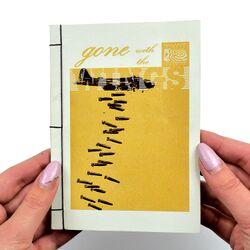 | |
| Author | Jérôme Puigros-Puigener |
|---|---|
| Language | French |
| Publisher | Habeas Corpus (4€) |
| City | Brussels |
| Date | 2010 |
| Pages | 40 |
| Format | 10.5 cm x 14.8 cm |
| Fabrication | Xerox, japanese-style binding |
| E-book | PDF (64 mb) |
Lil' Buddies Magazine
 | |
| Editor | Edie Fake |
|---|---|
| Language | English |
| Publisher | Secret Acres ($4) |
| City | Brooklyn, NY |
| Date | 2013 |
| Pages | 40 |
| Format | 14 cm x 10.8 cm |
| Fabrication | Softcover, stapled, silkscreen cover with full color offset |
| E-book | PDF (12 mb) |
Lil' Buddies Magazine is a publishing project by artist Edie Fake. Fake and contributors collect and present numerous photos of those frequently hand-painted anthropomorphic friends one can find in laundromats, ice cream carts, taco shops, and any other business or product that might benefit from having an object that has been given a happy face to put a personal spin on their goods and services.
Fake writes: “We live in an anthropomorphized world, a place where we assign to our surroundings traits that reflect our own image. From this basic impulse the phenomena of the Lil' Buddy unwittingly arises. Tapped directly into a human desire to relate through recognition, Lil' Buddies are rooted in a yearning to of the spirit to see ourselves as part of everything and, vice versa, to see everything as part of us. Lil' Buddies negotiate that tendency towards universality by integrating human images directly onto inanimate objects.”
Cómics de la Revolución
 | |
| Author | Francesc Ruiz |
|---|---|
| Language | Spanish |
| Publisher | Centre d'Art La Panera (free) |
| City | Lleida |
| Date | 2008 |
| Pages | 130 |
| ISBN | 978-8-4968552-8-1 |
| E-book | PDF (116 mb), Issuu (from artist) |
This installation is a modified version of Scott McCloud’s Reinventing Comics (translated into Spanish as La Revolución de los Cómics), a theoretical treatise in comic-book format that analyzes different aspects of this medium in order to enlarge and expand its spreading. It consists of 1,800 colour-toned copies piled up to resemble a city scale model in which the people’s faces have been replaced by the artist’s own face, thus reinforcing the idea of the copy and modification of the original. The modified text invites the reader/visitor to launch that will change our way of communicating and of perceiving art, supporting the idea of change. (from publisher)
Selected Work for Publications 2005-2010
 | |
| Author | Michael Baers |
|---|---|
| Language | English |
| Publisher | Heavy Traffic (14€) |
| City | Berlin |
| Date | 2010 |
| Pages | 104 |
| Format | 15 cm x 21 cm |
| Fabrication | Softcover |
| E-book | PDF (128 mb) |
This book brings together a selection of Baers’ work for magazines, journals and other print initiatives over a six year period. Subjects ranging from the Danish left wing terrorist group, Blekingegadebandens, to strategies for surviving societal collapse in Bucharest are treated by Baers in his inimitable style, which mixes 1960s underground comic aesthetics with the structural and formal distanciation techniques of Jean-Luc Godard and Harun Farocki. The ten works in this collection have previously appeared in the e-flux journal, Fucking Good Art, and the now defunct Danish art journal, Sum Magazine for Samtidskunst, and includes the first appearance of Michael Baers in A Home for Lost Ideas, a work commissioned for the public initiative, but for reasons having nothing to do with the work’s quality, was eventually not included in that publication. (from publisher)
We All Die Alone
 | |
| Author | Mark Newgarden |
|---|---|
| Editor | Dan Nadel |
| Design | Helene Silverman |
| Language | English |
| Publisher | Fantagraphics ($22) |
| City | Seattle |
| Date | 2005 |
| Pages | 192 |
| Format | 20 cm x 22.8 cm |
| Fabrication | Offset |
| ISBN | 978-1-5609766-1-5 |
| E-book | PDF (175 mb) |
Acclaimed cartoonist Mark Newgarden debuted in the first issue of RAW magazine in 1980 and his work subsequently found its way into a variety of high and low profile media. He co-created the 1980s pop culture fad Garbage Pail Kids, wrote, drew, and syndicated a weekly humor feature in the 1990s, and created a Web Premiere Toon for The Cartoon Network called B. Happy.
Newgarden's comics are hilarious, alarming, and masterful uses of the medium, alternating between old-time gags and avant-garde storytelling, often on the same page without missing a comedic beat. His syndicated strip in such publications as L.A. Weekly and The New York Press exerted a fresh influence on the medium. Today they remain as vital and entertaining as when they first appeared. Those syndicated comics make up the bulk of this book, the balance drawing on Newgarden's long form stories from various anthologies, including the much-lauded Love's Savage Fury.
In addition to compiling his comics, this book is a full picture of the artist, his influences, and his many other careers. An avid collector and historian of 20th century ephemera, Newgarden has achieved the rare distinction of both contributing to and furthering the mediums he collects: novelties, comics, and cartoons. Newgarden remains a great link to the past while moving ever further into the future. (from publisher)
Klassiker des Horrorfilms
 | |
| Author | Michalis Pichler |
|---|---|
| Language | German, English |
| Publisher | self-published (1€) |
| City | Berlin |
| Date | 2004 |
| Pages | 14 |
| E-book | PDF (8 mb) |
Scenes from classic horror films are juxtaposed with text taken from Eugen Blume's interview with art collector Friedrich Christian Flick.
Tomate
 | |
| Author | Guillaume Pinard |
|---|---|
| Language | French |
| Publisher | Lienart, Anne Barrault (10€) |
| City | Montreuil-sous-Bois, Paris |
| Date | 2010 |
| Pages | 32 |
| Format | 20 cm x 26.5 cm |
| ISBN | 978-2-35906-043-0 |
| E-book | PDF (13 mb) |
Guillaume Pinard’s oil paintings draw from childhood. He creates radiant, vivid, bright motifs. In a willingly schoolish way, he frames them in elementary, narrow perspectives. He isolates them in a sort of container without wrapping, a box, open surely not by accident, to reveal the “Oh, sorry! Me, that is this, too!" of their hidden nature. Whether they are a solar rabbit drinking the brew from a headless body, a proud well-hung horse, a virgin fiercely intending to remain so, or a vase with balls, the figures of Guillaume Pinard reveal his obsession with readability. (from publisher)
M-Maybe (Human Torch-Towering Inferno)
 | |
| Author | Sebastian Utzni |
|---|---|
| Editor | J. Steinbach |
| Texts | Daniel Baumann, Manuel Gerber, Gino Leoni, Thomas Milic, Katharina Ammann, Maxim Keller & Friedrich Melzer (futurzwei), Siri |
| Language | English |
| Publisher | Taube (9€) |
| City | Munich |
| Date | 2019 |
| Pages | 36 |
| Format | 17 cm x 26 cm |
| Fabrication | Offset |
| ISBN | 978-3-9459004-4-4 |
| E-book | PDF (36 mb) |
No super hero was able to prevent the attacks on the World Trade Center in 2001. Sebastian Utzni collected comics that were published between 1973 and 2001 and that show shockingly similarity to the images of the 9/11 attacks. (from publisher)
Suggestions d'harmonies
 | |
| Language | English |
|---|---|
| Publisher | Superstructure |
| City | Paris |
| E-book | PDF (22 mb) |
An appropriated reprint of a 1980 publication by the US Federal Emergency Management Agency (FEMA).
Lost: Works by Ed Ruscha (After Martin Lang)
 | |
| Author | Tate Foley |
|---|---|
| Language | English |
| Publisher | Work Press & Publication ($5) |
| City | Saint Louis, MO |
| Date | 2018 |
| Pages | 24 |
| Format | 14 cm x 22 cm |
| Fabrication | Risograph, saddle stitching |
| E-book | PDF (15 mb) |
This book contains possible/probable designs for 11 works on Ed Ruscha’s personal website listed as “missing works.” Each design is based on the relative style of the artist around the same time. (from publisher)
Euroboys Crysis
 | |
| Author | Yannick Val Gesto, Massimiliano Bomba, Leon Sadler |
|---|---|
| Design | Jean-Philippe Bretin |
| Language | English |
| Publisher | Collection revue (6€) |
| City | Paris |
| Date | 2012 |
| Pages | 28 |
| Format | 22 cm x 28 cm |
| E-book | PDF (41 mb) |
After having screen-printed a handkerchief for the Panos exhibition at Monte en L'Air, the revue Collection published a zine for the No Scrubs exhibition, with drawings by Massimiliano Bomba, Leon Sadler and Yannick Val Gesto.
ACT ESOL Language, Resistance, Theatre
 | |
| Author | Nicolas Vass, ACT ESOL |
|---|---|
| Editors | Nelly Alfandari, Amal Khalaf, Becky Winstanley, Frances Rifkin |
| Design | Elisabeth Klement |
| Language | English |
| Publisher | Serpentine Galleries (free) |
| City | London |
| Date | 2019 |
| E-book | PDF (87 mb), PDF (21 mb, from publisher) |
ACT ESOL is an ongoing practice-led collaborative research project initiated by Serpentine Projects in partnership with English for Action. The project brings together English for Speakers of Other Languages (ESOL) teachers and students with theatre director Frances Rifkin (Implicated Theatre) and artist researcher Nelly Alfandari to develop a political and participatory ESOL approach that combines language-learning with a focus on resistance.
The publication features a comic and illustrations by artist Nicolas Vass and is designed by Elisabeth Klement. ACT ESOL Research Group is: Nelly Alfandari, Dermot Bryers, Alexander Black, Elizabeth Graham, Amy Jowett, Amal Khalaf, Barbara Labiejko, Lawrence Leason, Liz Mytton, Silva Perin, Frances Rifkin, Jess Walker, Becky Winstanley and Nicolas Vass. (from publisher)
Mnémopolis (d’après Maurice Roche)
 | |
| Author | Françoise Rojare |
|---|---|
| Language | French |
| Publisher | Adverse (7€) |
| City | Paris |
| Date | 2016 |
| Pages | 32 |
| Format | 14 cm x 20.5 cm |
| E-book | PDF (42 mb), PDF (2008 reprint by Avance) |
In 1970, in the 5th number of the journal Change, subtitled "Le Dessin du Récit", Françoise Rojare attempted to graphically reinterpret one of the most significant books of literary modernity of the time: le Compact by Maurice Roche. Carried by a remarkably sharp gaze, Rojare aptly fed on Lettrist hypergraphics, typography, graphic scores and comics to produce 30 boards of dizzying avant-gardism, in no way diminished by the test of time. Some forty-six years after its realization, there is no doubt that the independent publication of this Mnemopolis will put in their place a number of conceited pseudo-innovators. (from publisher)
Perturbations
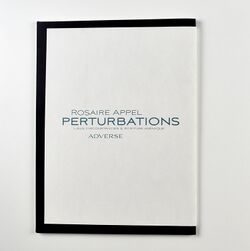 | |
| Author | Rosaire Appel |
|---|---|
| Language | French |
| Publisher | Adverse (10€) |
| City | Paris |
| Date | 2019 |
| Pages | 40 |
| Format | 19 cm x 25 cm |
| ISBN | 979-10-95922-30-8 |
| E-book | PDF (69 mb) |
A versatile American artist coming from the field of poetry, Rosaire Appel has been engaged since the 1980s in pioneering work in computer-assisted image making. Appel has a steady presence in New York galleries where she developed a significant production of publications and artists' books, from graphic scores to visual poetry, including experimental comics. Perturbations is her second book published by Adverse (after Intersections in 2017). In the present publication, Rosaire Appel radicalizes her research in comics, flirting more than ever with the limits of abstraction. On the basis of ghostly and fragmented architectural and topographical plans, she articulates her “asemic writing” (concrete poetry) and its entanglements of convoluted spaces in a visual explosion destabilizing all the accepted reading habits, definitively endorsing the comic strip as the ideal art with rhizomatic developments. (from publisher)
Manifeste
 | |
| Author | Alexandre Balcaen |
|---|---|
| Language | French |
| Publisher | Adverse (6€) |
| City | Paris |
| Date | 2016 |
| Pages | 40 |
| Format | 14 cm x 20.5 cm |
| E-book | PDF (41 mb), PDF (1 mb, from publisher) |
This inaugural manifesto of Adverse publishing house seeks to study how comics has evolved and transformed in recent years and broaden the register of what it might be.
Mi Propio Macanudismo
 | |
| Author | André Valente |
|---|---|
| Language | Portuguese |
| Publisher | Bebel Books (R$15) |
| City | São Paulo |
| Date | 2017 |
| Pages | 12 |
| Format | 15 cm x 21 cm |
| Fabrication | Offset printing on special paper, stamp made by the artist and Alice Prina |
| ISBN | 978-0-0007384-8-6 |
| E-book | PDF (14 mb) |
Mi Propio Macanudismo tells a story of translation and manual lettering of 500 comics strips from Argentinian cartoonist Liniers for a museum exhibition. The comic was released at the Feira Plana Fim do Mundo during the São Paulo Biennial. An English version is to be launched at the ELCAF - East London Comics and Arts Festival. (from publisher)
Intersections
 | |
| Author | Rosaire Appel |
|---|---|
| Language | French |
| Publisher | Adverse (17€) |
| City | Paris |
| Date | 2017 |
| Pages | 80 |
| Format | 15 cm x 23 cm |
| Fabrication | Glued perfect bound |
| ISBN | 979-10-95922-14-8 |
| E-book | PDF (101 mb) |
Rosaire Appel’s work has been introduced into Europe through the group exhibition Abstrakte Comics (Bremen, 2015, alongside Florian Huet, Pascal Matthey, Jérôme Puigros-Puigener, etc.). Appel is an North American digital artist exploring with determination and openness the infinite possibilities of text / image and image / image relationships; she creates experimental comics, graphic scores, digital collages, photographs and asemic writing (concrete poetry where words and letters deflect linguistic signification and become suggestive graphic sign). Appel is particularly interested in the regimes of gradual expansion and pollination, sensitive to the intimacy and duration of the reading experience rather than the fleeting gaze of the spectator, she favors the book over the exhibition and explores through her work the flexible boundaries between abstraction and figuration in dozens of artists' books published in micro-series or in print on demand. Among these, Intersections works on cartographic material, topographical surveys, diagrammatic iconography and a disparity of pictograms as so many elements which, linked in the great conceptual broth of the book factory, arouse the potential of a self-generated comics narrative. The text balloons become frames, the characters turn to pictograms, a background element is suddenly part of a foregrounding action, while the pseudo-scientific surveys and weapon motifs codify the world presented here through its crypto-militarist articulations. (from publisher)
A Final Companion to Books from the Simpsons
 | |
| Author | Olivier Lebrun |
|---|---|
| Language | English |
| Publisher | Yellow-pages, Rollo ($38.00) |
| City | Zürich |
| Date | 2018 |
| Pages | 640 |
| Format | 11.43 cm x 17.78 cm |
| Fabrication | Softcover, perfect bound |
| ISBN | 978-3-9062132-4-8 |
| E-book | PDF (829 mb) |
French graphic designer Olivier Lebrun follows on his previous publications documenting the books that appear in the popular cartoon television series with this anthology of more than 330 images and titles. All have been captured with a black-and-white animation screenshot and cataloged in alphabetical order. Ostensibly the final installment of this highly personal project by Lebrun, this new, updated edition reflects countless painstaking hours spent scanning episodes, plus the contributions of a large community of fans and readers who provided tips over the years. (from publisher)
Black Panther Coloring Book
 | |
| Author | FBI |
|---|---|
| Language | English |
| Date | 1968 |
| Reprint | Ruido y contexto, Buenos Aires, 2018 |
| E-book | PDF (14 mb) |
The Black Panther Coloring Book was released in 1968 and follows the journey of black (or white, depending on how you colour them) people from Africa to America, where they apparently all procured huge knives and started killing police. It makes the Black Panthers look like crazy, irrational lunatics and this was the point, because it was actually produced by the FBI and sent to white families across the country. It represented an effort to discredit the Panthers as any sort of valid political movement and reinforce the opinion that Huey P. Newton and his organisation were psychotic militants who killed white people and police indiscriminately.
House
 | |
| Author | George Wylesol |
|---|---|
| Language | English |
| Publisher | Tan and Loose ($12.00) |
| City | Los Angeles |
| Date | 2017 |
| Pages | 32 |
| Format | 14.5 cm x 21 cm |
| Fabrication | Risograph, paperback, staple bound |
| E-book | PDF (26 mb) |
Do you ever wonder what would have happened if your life unfolded differently? If you accepted that job offer, missed that bus, never moved from your hometown as a child? House collection of vignettes imagining the everyday sentimentality of a different path. (from publisher)
Cordel Urbano
 | |
| Author | Lapi (Luiz Antônio Pires) |
|---|---|
| Language | Portuguese |
| Publisher | Ouvidor ($35.00) |
| City | Rio de Janeiro |
| Date | 1973 |
| Pages | 56 |
| Format | 13 cm x 18 cm |
| E-book | PDF (57 mb) |
Luiz Antônio Pires, better known by the pseudonym Lapi, had his first cartoons published in the extinct O Jornal, by the Diários Associados. He also worked for Jornal do Brasil, collaborated with the communist publications Pasquim and Adiante, in addition to creating, in 1973, Cordel Urbano, a booklet that was the size of those little cordel leaflets, only a little fatter, but the role was the same. Lapi was the project leader for urban depollution in Rio, collaborating with paintings in the Rocinha favela, Morro Dona Marta, entrance to the Tunnel Velho, in Copacabana, and at the Hospital Pinel. Lapi died at the age of 60 of a heart attack, in Rio de Janeiro.
Il Fumetto dei Giardini
 | |
| Author | Francesc Ruiz |
|---|---|
| Language | English |
| Publisher | self-published (25€) |
| City | Barcelona |
| Date | 2015 |
| Pages | 80 |
| Format | 17,8 cm x 12,7 cm |
| Fabrication | 5 booklets, 16 pages each, softcover |
| E-book | PDF (97 mb) |
Il Fumetto dei Giardini is a comic in installments temporarily distributed during the opening week of 56 Biennale di Venezia. The booklets were collected, remixed and customized by Francesc Ruiz for the exhibition The Subjects, curated by Martí Manen in the Spanish Pavillon in 2015. (from publisher)
Lazing West No 1
 | |
| Author | Michael e. Casteels |
|---|---|
| Language | English |
| Publisher | Puddles of Sky Press ($15.50) |
| City | Kingston, ON |
| Date | 2017 |
| Pages | 8 |
| Format | 22 cm x 28 cm |
| Fabrication | Hand-sewn binding |
| E-book | PDF (13 mb) |
Lazing West No. 1 is a collection of comic-poems borrowing from Golden Age comics that are now in the public domain. The source material Blazing West was originally published by American Comics Group in 1948-1951. These comics have been broken apart and re-assembled frame by frame. Rather than focusing on narrative or character or plot, these comics focus on shape, color, texture, repetition. This process has created these surreal-western-visual poetry-comics. (from publisher)
Les Romans Graphiques
 | |
| Author | Habeas Corpus |
|---|---|
| Language | French |
| Publisher | Habeas Corpus |
| City | Brussels |
| Date | 2019 |
| Pages | 10 |
| E-book | PDF (20 mb) |
Obscurcité
 | |
| Author | Loïc Largier |
|---|---|
| Language | French |
| Publisher | Adverse (7€) |
| City | Paris |
| Date | 2017 |
| Pages | 24 |
| Format | 17 cm x 24 cm |
| Fabrication | Manually bound |
| ISBN | 979-10-95922-13-1 |
| E-book | PDF (32 mb) |
According to a strategy of overlap acting as much as a scrambling as a revealer, Loïc Largier's method plays with distributions and accumulations of patterns drawn from a large corpus of popular comics. For this Obscurcité, the work in black on black adds to the radicality of an approach engineered here exclusively with urban motifs. The city here does not become so much a subject as a device, inviting us to question ourselves on what the use of urban design can offer us as a reading experience through the prism of a comic strip which borrows its models (in particular as a space of superimposed situations, thoughts of organizations and flow of movements of the bodies). On the basis of a bank of some 850 motifs, Loïc Largier takes us in a haunting drift to the point of vertigo, disturbing our overall reference points to sublimate the details, offering to the play of circulation of the eye in the board original cross roads. (from publisher)
Panorama du Feu
 | |
| Author | Jochen Gerner |
|---|---|
| Language | French |
| Publisher | L'Association (49,70€) |
| City | Paris |
| Date | 2010 |
| Pages | 400 |
| Fabrication | Box set containing 51 booklets, total weight: 719 g |
| ISBN | 978-2-84414-355-6 |
| E-book | PDF (391 mb) |
Le Panorama du Feu is one of the main pieces of Gerner’s solo exhibition presented at the Anne Barrault gallery in September 2009. The artist revisited covers of a large variety of so-called war literature booklets from the 1960s and 1970s. He covered multiple areas in black, highlighted specific words or included pictograms in the old booklets. The author thus highlights the violence of these popular periodicals from the Cold War era. The result is an Oubapian book-object par excellence, an atypical assemblage made up of 50 booklets of 8 pages each gathered in a box. (from publisher)
Remake
 | |
| Author | Luis Aranguri |
|---|---|
| Language | Portuguese |
| Publisher | Meli-Melo (R$30,00) |
| City | São Paulo |
| Date | 2015 |
| Pages | 20 |
| Format | 14.8 cm × 21 cm |
| Fabrication | Risograph |
| E-book | PDF (36 mb) |
A narrative assembled from fragments of the book Akte: Studien, Kompositionen und Visionen.
Retour vers le centre
 | |
| Author | Sammy Stein |
|---|---|
| Language | French, English |
| Publisher | self-published (sold out) |
| City | Paris |
| Date | 2015 |
| Pages | 12 |
| Format | 24,5 cm x 17 cm |
| Fabrication | Risograph, paperback, staple bound |
| E-book | PDF (14 mb) |
Trous gris
 | |
| Author | Michel Vachey |
|---|---|
| Language | French |
| Publisher | Adverse (10€) |
| City | Paris |
| Date | 2017 |
| Pages | 40 |
| Format | 14.5 cm x 20 cm |
| ISBN | 979-10-95922-09-4 |
| E-book | PDF (40 mb) |
Best known for his work as a writer, poet and essayist, Michel Vachey is no less engaged in a number of stimulating plastic research which unfortunately remained largely confidential. Anchored in particular in an assiduous practice of redaction, cutting and collage, Michel Vachey has thus carved out a furrow as rich as it is secret, with an influence as diffuse as it is decisive. Trous gris is made up of two unpublished series of drawings (collages, stamps, painting, perforation, etc.) dating from 1978 and which should be brought together and finally presented, in that they constitute a remarkable formal approach to serialization, around motifs suspended in balance on the thin thread separating abstraction from figuration. (from publisher)
The Street
 | |
| Author | Francesc Ruiz |
|---|---|
| Language | English |
| Publisher | GIBCA 2017 (free) |
| City | Gothenburg |
| Date | 2017 |
| Pages | 14 |
| E-book | PDF (8 mb) |
Francesc Ruiz has undertaken extensive research into the history of comic books, particularly in relation to issues of subculture, social class and sexuality in different cultural contexts. For this project titled The Street, he was interested in creating the construction of narratives using a commercial street as non-linear comics in which every shop window works as one panel of a comic strip. The installation took the form of a life-size street, made through a large drawing by Ruiz, which people could walk through to view. Ruiz designed and built an actual street façade structure based on his drawings, similar to the ones used on the sets of films and TV series, creating only the façade, to simulate a street. This street was approximately 20 metres in length, and was presented outdoors in public space and developed in a site-specific way, following site research undertaken by Ruiz in Gothenburg. (from publisher). The accompanying booklet was given away during the show.
Communes du livre
 | |
| Author | L.L. de Mars |
|---|---|
| Language | French |
| Publisher | Adverse (6€) |
| City | Paris |
| Date | 2017 |
| Pages | 28 |
| Format | 14,8 cm x 21 cm |
| ISBN | 979-10-95922-11-7 |
| E-book | PDF (45 mb), PDF (2 mb, from publisher) |
As part of the discussions led by the Syndicate of Alternative Publishers (association created in 2014 bringing together today more than forty comic book publishers), LL de Mars has developed a system of circulation and marketing of the book with the fierce desire to finally free itself from the crushing cogs of a self-devouring industrial distribution. Based on communal, even communist operating principles, this model claims to finally offer visibility and accessibility to the countless wonders emerging from a fragile, precious and underground production. Behind its utopian attire, a project is as concrete as it is realistic, tackling with an unprecedented force of imagination the question of politics and commitment in the field of editorial production as much as in that of the dissemination of art and knowledge. (from publisher)
1000X
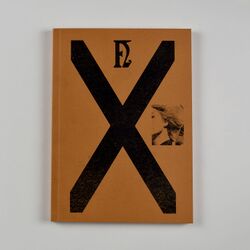 | |
| Author | Raul Luna |
|---|---|
| Language | Portuguese |
| Publisher | Livros Fantasma |
| City | São Paulo |
| Date | 2018 |
| Pages | 80 |
| Fabrication | Risograph |
| E-book | PDF (72 mb) |
This "ode to visual ruin" collects logos and emblems and navigates between the word and the image, the icon and the index.
Filer
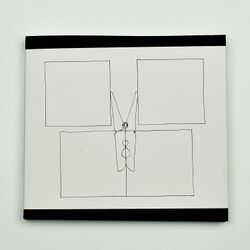 | |
| Author | Guillaume Chailleux |
|---|---|
| Language | French |
| Publisher | Adverse (15€) |
| City | Paris |
| Date | 2019 |
| Pages | 96 |
| Format | 15 cm x 16 cm |
| ISBN | 979-10-95922-26-1 |
| E-book | PDF (66 mb) |
Three years after the publication of Fils, his first remarkable book, Filer compiles all of Guillaume Chailleux's work on one of the most minimal devices in comics: the four-panel waffle iron. Partly published in the journal Pré carré, this series of variations is a critique of figural questions, like a playful poetic machine. In so many subtle elliptical designs, the author suggests other possibilities for the meanings of the comic strip. (from publisher)
Astro Boy 06
 | |
| Author | Corentin Garrido |
|---|---|
| Language | French |
| Publisher | La Cinquième Couche (15€) |
| City | Brussels |
| Date | 2020 |
| Pages | 240 |
| Format | 14,9 cm x 21,2 cm |
| Fabrication | Album BD en noir & blanc, Couverture Souple sous Jaquette |
| ISBN | 978-2-390-08060-2 |
| E-book | PDF (129 mb) |
Taking up the logic of diversion of the Essaim collection, developed at La 5e Couche, Corentin Garrido has completely redesigned volume 6 of the adventures of Tezuka's flagship hero, only retaining the graphic codes: speedlines, speed lines, etc. Any figure or any element of decoration is obliterated in favor of an abstract ballet of expressive features which summarize the essence and the dynamics of the story. His approach echoes art historian Ryan Holmberg's brilliant study of speed lines in the manga, which appeared in the 9th volume of La Crypte Tonique, L'oeil sur les rails. (from publisher)
La Méthode Bernadette
 | |
| Authors | Laurent Bruel, soeurs Bernadette |
|---|---|
| Texts | François Cheval, Sonia Floriant |
| Language | French |
| Publisher | Matière (15€) |
| City | Montreuil |
| Date | 2008 |
| Pages | 167 |
| Format | 15 cm x 21 cm |
| ISBN | 978-2-916383-04-0 |
| E-book | PDF (154 mb) |
In the early 1930s, in the small industrial town of Thaon-Les-Vosges, a group of young virgins, secretly dedicated to the Catholic Church, to Christ –the “Bernadette sisters”– design a striking catechism method based on stencil technique: black silhouette on a white background.
Thus begins the “Bernadette epic”: the incredible adventure of a community of women, who for 30 years will think, express themselves, act and fight with pictures and images. For the adventure is a combat. The purpose is to fight the intellectual, moral, political artistic depravation of the modern world. The aim is to fight image to image, fight with the same weapons against “materialist art, cubist and communist”. In the heat of the 20th century, the objective is to counter attack modernity, no less. White against black, picture against picture.
“Silhouette as a teaching method gives a maximum photographic impression on the retina”: the Bernadette sisters design stencil pictures of a singular effectiveness: cut out with scissors or knives. Sharp images.
70 years after they were designed, the Editions Matière publishing company has rediscovered these hundreds of pictures and prints and have edited them as a “bande dessinée”, a comic strip. The extraordinary visual and narrative strength of the Bernadette stencils is still intact today. Via this new set up, the Method tells its own story, reveals the story of its invention, unveils its issues, its ambitions, its rise and fall: the ban by the Catholic Church, its vain attempts to auto censorship and finally the long oblivion till today’s rediscovery. (from the publisher)
Illiterature
 | |
| Editor | Michael e. Casteels |
|---|---|
| Language | English |
| Publisher | Puddles of Sky Press ($12) |
| City | Kingston, ON |
| Date | 2015 |
| Pages | 76 |
| Format | 17.8 cm x 21.6 cm |
| Fabrication | Perfect bound |
| ISBN | 978-0-9939454-4-1 |
| E-book | PDF (78 mb) |
illiterature. issue v. is a graphic novel of collaboration. Part visual poetry, part comic book, the work of fifteen contributors is meshed together into a seamless, abstract narrative. The anthology features works from Nelson Ball, Gary Barwin, derek beaulieu, Amanda Earl, Claudio Ghirardo, Faye Harnest, Gene Kannenberg, Jr., Mark Laba, Mark Laliberte, Chris Piuma, sven staelens, Lin Tarczynski, andrew topel, Dale Tracy, & Nico Vassilakis. (from publisher)
TNT en Amérique
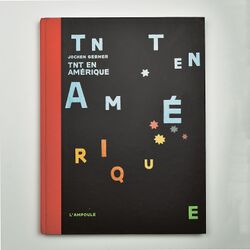 | |
| Author | Jochen Gerner |
|---|---|
| Language | French |
| Publisher | L'Ampoule (28€) |
| City | Paris |
| Date | 2002 |
| Pages | 66 |
| Format | 22,3 cm x 29,5 cm |
| Fabrication | 1 affiche insérée. Relié avec dos toilé |
| ISBN | 978-2-848040-00-9 |
| E-book | PDF (94 mb) |
“The main interest for me of the comic strip is the infinite possible links between text and image: a system of representation continually confronting, in a kind of alchemy, text and picture. This is the field I endeavour to explore on my own or with OuBaPo (Ouvroir de Bande dessinée Potentielle).
The idea for TNT en Amérique sprang from these remarks with OuBaPo, from exercises, experiments. I try to find new reading perspectives. I dismantle a given material to make something else of it.
Through analysing Hergé’s comic strip Tintin en Amérique I realized the recurring incident of fall (of bodies) in this book. I wanted to understand where this permanent giddiness came from. Early 2001, I began to understand this violence (violence always softened and made seem ordinary thanks to the clear line of the drawing: getting punched is much more violent than what is shown in this kind of book) and I decided it would be the opportunity to do an “oubapian” exercise with the whole book.
Therefore all this was only a personal experience at the beginning. I first analyzed and dissected the text in Hergé’s balloons. Then I kept the words for their meanings (in relation with the violence and the symbolical themes of American society) and their musical qualities. I drew up lists.
I tried to elaborate sets of themes according to the pages. At that time, I began to blacken Hergé’s drawings letting out only the words I thought important. Later on, I found the graphic solution by enlightening this black with “openings” on colour, while completing the text by images. Black has then become night since all these coloured spots (signs, pictograms, simple symbols) were becoming urban little lights, pop neon lights flickering in the violent darkness of the American city. A kind of tentacular city watched by night from the sky or a promontory ( a recurrent scene in American films). Black in reference to censorship, to night, to darkness ( evil ), the mystery of uncompletely revealed things.
On a dense black background, light coloured vignettes tell a story of American violence through their sequene and insistence: I bring up this phenomenon as well as the notions of noises, movements, money, religion, Good and Evil connected to it (the first moving neon sign in the United States was used to announce a death sentence). This night is an “American night”: a filter on an image taken in daylight to give the illusion of night.
The reader’s mind (who should have read Tintin en Amérique beforehand) must be able to go from Hergé’s underlying work to my graphic indications and back. This graphic intervention is as much about America through one of Hergé’s comic strip, as it is about Hergé’s work through the themes about America.
For these two universes, Hergé’s light line and American society can be understood in the same way: both worlds apparently rich, beautiful, smooth, but radically dark and violent. So I was able, thanks to reframing, masking, covering up to use a given material in order to examine its unexploited contents as well as its obscure zones.
From a technical point of view, I bought (in shops specialized in old editions) old copies of Tintin en Amérique. Therefore I worked directly on the printed editions by cutting the pages one by one and covering them thickly with black ink. The elements of the original work were not to be seen showing through. It is for the same reason the publisher suggested I should rewrite the selected words myself for the printed version because Hergé’s handwriting could not be copied without authorization.
The book was logically made by following the covering up concept thoroughly. Every word in its original place, each page in its place in the book. The publisher’s address and the colophon were put in the same places. The flyleaves and the clothbound back refer to Hergé’s original editions.
I did not see this book as a “technical feat” but as the discovery of a secret passage , of a dark track followed to the end. I do not try to respect a fixed form or to keep faithful readers through my style of drawing. I make my books according to the theme and the issue at stake.
This book was published in 2002 by Ampoule publishers. After September 11th 2001, when I was working on this book, I did not change anything about my work. At that time I had chosen all the words I was to keep, I had written the quatrains placed at the end of the book. I had also drawn the first fifteen pages. Later on I realized I was working on topical questions. Some sequences in TNT en Amérique strangely echoed perfectly what was going on at the time: bomb attack/ terror/revenge/pursuit/cave/dollars/crisis.
Last, this book was not made against Tintin or for Tintin but about Tintin. A piece of work on and about the comic strip.” (author’s statement)
Suit(es)
 | |
| Author | Robert Varlez |
|---|---|
| Language | French |
| Publisher | Adverse (20€) |
| City | Paris |
| Date | 2016 |
| Pages | 144 |
| Format | 14,9 cm x 21 cm |
| ISBN | 979-10-95922-06-3 |
| E-book | PDF (136 mb) |
Robert Varlez is arguably best known for his work as an editor in L'Atelier de l´agneau, a publishing house for literature, poetry and visual arts. As an illustrator, he collaborates with various poets and writers such as Izoard, Ben Jelloun or Butor, and it is thanks to the encouragement of Martin Vaughn-James that he embarked on a series of experiments in comics based on Muybridge’s chronophotographs. These works, published in the 1970s in various journals such as Minuit or To Be Continued..., remain in confidentiality until their rehabilitation by The Hoochie Coochie publishing team. In 2015, encouraged by the interest of a new generation of readers, a feverish impulse engages him in the production of a copious series of plates operating the ideal synthesis between his work as a comic book author, collagist and plastic surgeon. He thus gave birth to Suit(es), a machinery of dismemberment and recomposition that is both enjoyable and complex, in turn playful and overwhelming, the culmination of an art skilfully developed throughout his rich career. (from publisher)
La ballade de la mer salée
 | |
| Author | Ilan Manouach |
|---|---|
| Language | English |
| Publisher | La Crypte Tonique, La Cinquième Couche (20€) |
| City | Brussels |
| Date | 2020 |
| Pages | 168 |
| Format | 22,4 cm x 29,4 cm |
| E-book | PDF (105 mb) |
A remake of a colonial classic of graphic literature, La ballade de la mer salée is an unauthorized facsimile of the original from Casterman editions, which was commissioned and produced entirely by an artist living on a Pacific island, visited by the series’ central character, Corto Maltese.
Astro Boy 6
 | |
| Authors | William Henne, Xavier Löwenthal |
|---|---|
| Language | French |
| Publisher | La Cinquième Couche (25€) |
| City | Brussels |
| Date | 2020 |
| Pages | 240 |
| Format | 15 cm x 21 cm |
| ISBN | 978-23-90080-61-9 |
| E-book | PDF (324 mb) |
Astro Boy, the Little Robot is a shonen manga by Osamu Tezuka, published between 1952 and 1968. This sci-fi series takes place in a futuristic world where robots and humans coexist. It is based on the adventures of Astro Boy (often referred to simply as Astro), a powerful robot created by the head of the Ministry of Science, Dr. Tenma, to replace his son Tobio, who died in an accident. Dr. Tenma builds Astro identically to Tobio and raises him as he would his own son. He soon realizes that the robot cannot fill the void left by his son, Astro unable to express character traits or grow old like any human does. Remaking, with one detail, an identical book, in compliance with the Essaim charter, to modify, correct or revive its reception and meaning, is reminiscent of Borges' short story, “Pierre Ménard, author of Quichotte”, which describes the life and work of the imaginary writer Pierre Ménard. He details his incredible project to rewrite and update the first book of Quixote. After a lifetime of effort, arriving at this new contemporary and perfect form, he reproduced Cervantes’ work identically, in archaic 15th-century Spanish. Borges justifies this work and demonstrates that Ménard's result is superior to the original: if Cervantes wrote banally in the Spanish of his time, Ménard engaged in a linguistic creation similar to that of these historical novels of the 19th century, which present two identical passages that the context of their writing nevertheless makes opposing. The Essaim collection brings together creations resulting from diversions, strictly respecting a charter requiring that one modification, only one, be made on the whole of a work which modifies, corrects or revives its reception and meaning. The subversion described by Karl Marx, by which Marchandise(Merchandise) > Argent (Money)> Marchandise (Merchandise) became A> M> A ', allowing the accumulation of capital through the exploitation of labor value, then simply A> A', finds its artistic expression here contemporary: M> A> A '> A' '..., ad libitum, or even A> A> A'> A ... where the first A is that of Astro Boy. In few words, the authors bought 300 copies from the original publisher, at a discount, and sell now each copy at the exuberant price of 25€. (from publisher)
Au Travail
 | |
| Author | Manuel |
|---|---|
| Language | French |
| Publisher | La Crypte Tonique (5€) |
| City | Brussels |
| Date | 2019 |
| Pages | 224 |
| Format | 7.6 cm x 11.6 cm |
| E-book | PDF (128 mb) |
Blow Books is a project initiated in 2017 by Philippe Capart (head of La Crypte Tonique) with an idea to sell small format picture books (7.6 x 11.6 cm) through specialised vending machines at a low price (5 euros). As stated in their press release, “bande dessinee, by abandoning the press cartoons in favor of the book format, and then by generalising the use of large hardcover formats, whatever the quality of their content, cease to be popular: due to their high price, they are no longer accessible to the regular reader. For their part, because of their price, graphic novels in various formats always address the privileged few. Blow Books is therefore a humble proposal to get out of this situation”. Au Travail, is one of the collection’s books and comes from Liège-based comics artist Manuel, who is also known for his work published by l’Association in France. (from publisher, amended)
Donald Duck Has a Universal Desire
 | |
| Language | English |
|---|---|
| Publisher | self-published (10€) |
| Reprint | Francesc Ruiz, Barcelona |
| E-book | PDF (12 mb) |
A reprint of the famous 1930s Tijuana Bible (pornographic ripoff of famous comics) where Donald's desperation for a lady duck leads him to “perversion”.
Fahrenheit 451's Comic
 | |
| Author | Francesc Ruiz |
|---|---|
| Editor | Valérie Cudel |
| Language | Spanish |
| Publisher | Captures (15€) |
| City | Valence |
| Date | 2016 |
| Pages | 8 |
| Format | 20 cm x 30.9 cm |
| ISBN | 978-2-9533912-9-9 |
| E-book | PDF (18 mb) |
This is a reconstitution of a textless comic book appearing at the beginning of François Truffaut's film Fahrenheit 451 (1966), where it is browsed for a few seconds by main character while lying in bed. With this publication, Spanish artist Francesc Ruiz also questions the status of the comic book at the time the film was made and also within the dystopian universe originally created by Ray Bradbury.
The 8-page publication contains some original images of the comic from the movie itself and others taken from the still film images from the shooting and was completed after research on styles and authors of the period, mixing some material borrowed from James Bond comic strips (Truffaut's film was shot in Pinewood Studios in London with the same production team as the James Bond movies) with new content that helps to understand the meaning of both the film and the novel, adding a new narrative perspective.
The limited edition of 400 copies was published on the occasion of the exhibition No Words, 3 Walls, 3D Porn, at the Florence Loewy Gallery in Paris, which was open from 15 October - 18 December 2016. (from publisher)
Le Royaume
 | |
| Authors | Jérôme Mulot, Florent Ruppert |
|---|---|
| Language | French |
| Publisher | L'Association (12€) |
| City | Paris |
| Date | 2011 |
| Pages | 28 |
| Format | 41 cm x 58 cm |
| ISBN | 978-2-84414-406-5 |
| E-book | PDF (110 mb) |
Le Royaume echoes Ruppert & Mulot's previous project, Del Aventure, in its layout of 41 x 58 cm folded in four. We can guess which Le Royaume [The Kingdom]: that of shadows, of the dead, all of this floating in space, each having taken what he or she thought, car or chair. But this is not the Le Royaume’s only narrative, which contains dozens parallel stories, making perfect use of such a gigantic format. (from publisher)
Codex
 | |
| Author | Felipe Muhr |
|---|---|
| Language | Spanish |
| Publisher | La Mano (10.000 CLP) |
| City | Santiago |
| Date | 2018 |
| E-book | PDF (49 mb) |
A work in progress, Codex is a visual encyclopedia of encyclopedias. The series is a free-association graphic study based on the Enciclopedia Codex, an illustrated encyclopedia published in Chile during the late 1950s. In an exercise of re-classification, the objects in the encyclopedia are given new meaning through strict visual rules where every drawing has some correlation with the next one, following a general infographic flow. Codex is an open-ended exploration on how we understand categorical thinking through the use of graphic language. Codex started first as a series of drawings on vellum paper and cut-out ink drawings. A book with a selection of drawings was printed on transparent paper by La Mano Ediciones in Santiago, 2018. (from publisher)
The Oasis
 | |
| Author | Sammy Stein |
|---|---|
| Language | French, Occitan, English, Japanese |
| Publisher | self-published (14€) |
| City | Saint-Férreol-Trente-Pas |
| Date | 2019 |
| Pages | 24 |
| Format | 20 cm x 26 cm |
| Fabrication | Risograph, paperback, staple bound |
| E-book | PDF (27 mb) |
The 20 pages of The Oasis were concieved during the L'oasis residency, set up by Antoine Marchalot, Margaux Duseigneur, Chloé Munich, Vincent Lalanne, Pauline Barzilaï from 1-15 July 2019 at Le Sénéchal hotel in Uzerche, Corrèze region (France). These pages were freely inspired by local landscapes, and the works produced by the participants of the residency, which include le Chevalier expansé (the Expanded Knight) by Martin Carolo, cherries from the market, the wind, some of the town gates, the puppets by Chloé Munich and Vincent Lalanne, the parchment written by Paul Descamps and Martin Carolo, the raindrops, the candles found at Emmaüs charity shop in Brive-la-Gaillarde, the finials (ornaments traditionally positioned on rooftops), the library of Uzerche (from publisher)
Compendium of Francobelgian Comics
 | |
| Author | Ilan Manouach |
|---|---|
| Language | French |
| Publisher | La Cinquième Couche, Forlaens, L'Endroit, Fortepressa, Hélice Hélas, Topovoros, Antilope, Gnat (18€) |
| City | Brussels, Copenhagen, Rennes, Rome, Athens, Veuvey, São Paulo, Tel Aviv |
| Date | 2018 |
| Pages | 48 |
| ISBN | 978-2-39008-018-3 |
| E-book | PDF (51 mb) |
Compendium of Francobelgian Comics (Abrégé de bande dessinée franco-belge) was published in 2018 in book catalogues of eight publishers in Europe and elsewhere. Abrégé was built following the precepts of ontography, a model of conceptual representation for objects theorized by video game designer and OOO philosopher Ian Bogost. Compendium presents a visual a personal typology of graphemes drawn from a shared reservoir of the Franco-Belgian bande dessinée tradition, where one can find a variety of comics proto-memes, metanarrative devices, paratextual elements and building blocks of the European BD.
Compendium of Franco-Belgian Comics takes as its starting point the 48CC comic book format. The name, contemptuously christened by the alternative publisher l’Association, points to the product of a normative and just-in-time book industry that dominates the French speaking publishing industry. During a single afternoon, I purchased from second hand shops a selection of forty-eight 48CC books and after a careful reading I built a non-exhaustive idiosyncratic index of elements considered to generally define the tradition of Franco-Belgian comics. Among a variety of comics proto-memes, metanarrative devices, paratextual elements and other hovering dark clouds, shark wings, identity stereotypes and body-shaped holes, Compendium presents an orchestral comic book, where instantiations of this typology, freed from the imperatives of specific narratives can be read as the in situ building blocks of the European BD.
Compendium invites readers to forensically parse the cited works by foregrounding as in for themselves the heterogeneous objects of a local comics industry. It points toward the constitution of new practices of indexation. It uses the concept of the ontograph as a way to present comics as objects, without requiring an interpretation that comes from the elucidation of the original narrative functionalities, or having to demonstrate the referential significance of distinct narrative units and building blocks. By merely charting the networks among reading experiences, Compendium provides a virtually present construct of relational juxtapositions and claims the irreducibility of objects to their effects or compounds. Compendium argues for the necessity of different modes of reading in relation to comics by exemplifying how combined modes of an approach to a text can allow new works to develop. Its objects are freed from the imperatives of the specific narrative in which they were initially implemented, and from the correlations implied by storytelling functionalities. Similar to an autopsy, the distinct narrative units and the building blocks of the Franco-Belgian comics tradition are laid bare, emerging and imposing themselves as dense singularities.
The Cubicle Island
 | |
| Author | Ilan Manouach |
|---|---|
| Language | English, a.o. |
| Publisher | La Cinquième Couche, Forlaens (60€) |
| City | Brussels, Copenhagen |
| Date | 2020 |
| Pages | 1500 |
| Format | 18.3 cm x 26.1 cm |
| ISBN | 978-2-3900805-1-0 |
| E-book | PDF (817 mb) PDF (71 mb) |
The Cubicle Island Pirates, Microworkers, Spambots and the venatic lore of clickfarm humor is a conceptual comic book project, and an experiment with the distributed ramifications of digital labor. The book collects hundreds of desert island cartoons, a genre that reached the peak of its popularity in 1957, possibly as an expression of Cold War fear of the nuclear bomb. I have de-texted the original text captions and solicited microworkers, through the interface of a popular digital labor platform, to submit a funny text between 50-70 words for each one of the cartoons. Microworkers are most often asked to complete tasks for which no efficient algorithm has yet been devised. They are considered to be the operators of the smallest unit of work in a virtual assembly line. The term "microwork" describes a series of small tasks that are completed by many people across the Internet to comprise a large unified project, such as this book. It refers to the deployment of human labor occurring in platform-mediated, zero-hour contract regimes that benefit minimal transactional frictions and the absolute circumvention of applicable minimum wage laws. As a labor force, microworkers find themselves in an important moment in the history of labor; a stepping stone to Artificial General Intelligence’s exponential acceleration of technology that promises a new era of social and economic abundance.
The Cubicle Island is a durational performance based on fifty years of desert island press cartoons. The performance highlights the extreme isolation that accompanies new regimes of work alongside the making of an international class of precarious cognitive workers. The book labors silently through the products of an extremely deskilled textual workforce, both human and non-human, and embraces the epistemic and technological accelerationism championed by the interconnectedness of the global precariat. In the age of surveillance capitalism’s selective transparency, it thematizes new formations of labor and leisure.
Líneas Cinéticas
 | |
| Author | Martín Vitaliti |
|---|---|
| Text | ferranElOtro |
| Language | English, Spanish |
| Publisher | Save as...Publications (10€) |
| City | Barcelona |
| Date | 2009 |
| Pages | 56 |
| Format | 15 cm x 21 cm |
| Fabrication | Poster, glued |
| ISBN | 978-84-936956-4-4 |
| E-book | PDF (35 mb), PDF (1 mb, from publisher) |
This publication is a study of one of the temporal resources regularly used in comic to represent movement: kinetic lines. This edition puts together a selection of drawings in which kinetic lines from superhero comic books have been isolated using the digital erasure of the other elements on the rest of the page. By isolating these elements from the rest of the information, they end up turning into independent objects. These abstractions are no more the context that gave sense to the main action, but the stars of a new story. (from publisher)
Didascalias
 | |
| Author | Martín Vitaliti |
|---|---|
| Language | English, Spanish |
| Publisher | Save as...Publications (10€) |
| City | Barcelona |
| Date | 2013 |
| Pages | 38 |
| Format | 15 cm x 21 cm |
| Fabrication | Poster, glued |
| ISBN | 978-84-938430-2-1 |
| E-book | PDF (18 mb), PDF (1 mb, from publisher) |
This publication contains a selection of rectangular cartridges with temporal information which are commonly used in comics to include the voice of the narrator: the stage directions. These text boxes have been isolated from other information in the vignette. Thus, these elements become independent objects, they no longer are clarifications to understand the timing of the main action and become the stars of a new narrative sequence. (from publisher)
Fondos
 | |
| Author | Martín Vitaliti |
|---|---|
| Text | Irene Minovas |
| Language | English, Spanish |
| Publisher | Save as...Publications (5€) |
| City | Barcelona |
| Date | 2013 |
| Format | 60 cm x 84 cm |
| Fabrication | Poster, jacket |
| ISBN | 978-84-938430-4-5 |
| E-book | PDF (19 mb), PDF (1 mb, from publisher) |
This publication contains a selection of different comic vignettes in which the backgrounds have been isolated by deleting the characters that appeared in them. In these drawings, the space these characters occupied, has been digitally redrawn. Thus, the scene is no longer secondary or just the context in which the main action takes place, but becomes the "subject" of the action. (from publisher)
Untitled
 | |
| Author | Inès Chuquet |
|---|---|
Arjun Appadurai in The Social Life of Things, describes the socially relevant life of commodities. Commodities embody a value that can be exchanged and thus are defined as “things with a particular type of social potential, that are distinguishable from "products," "objects," "goods," "artefacts," and other sorts of things.” Quoting Georg Simmel, a commodity can be “any thing intended for exchange”, as value is never an inherent property of objects, but is a judgement made about them by subjects, driven by their desire to possess them. Politics is what creates the link between exchange and value, and these things have “no meanings apart from those that human transactions, attributions, and motivations endow them with.” Exchange, therefore, is the source of value, a formative phase of the commodities’ becoming; the circulation of things enlivens them. According to Appadurai “all efforts at defining commodities are doomed to sterility unless they illuminate commodities in motion”. An integrated part of the commodity pathway is what Appadurai calls the diversion of commodities, “the placement of objects and things in unlikely contexts”. Diversion occurs in and out of commoditization, when a thing is removed from its commodity pathway for different reasons, or when a thing formerly retrieved from its customary circuits, is re-commoditized after a long lapse. Taking from Appadurai’s work, it is possible to examine material cultures and the ways in which movements and migrations of populations have altered the meanings, uses and exchanges of the things they carried, sold or propagated, and the things they left behind.
But what happens to things when they are left behind and when no motion illuminates them anymore? When their customary circuits don’t overlap with trajectories of exchange, things, instead of a social life, reclaim a life. What happens when things, put it in Simmel’s terms, don’t “resist our desire to possess them” or when their economic value does not motivate any exchange of sacrifices? What happens, in a technological age of industrially proportioned consumption that produces an effluence of disposable consumer goods, when things deceive their programmed social potential? Beyond inscribed processes of mutability and mobility relevant to value exchange, the physical materiality of things is asserted.
For most of her life, Inès Chuquet suffered from what she described as persistent difficulty discarding possessions. Recently separated from the general category of obsessive-compulsive behaviours, hoarding disorder is designated as the compulsive urge to acquire unusually large amounts of properties and the inability to voluntarily get rid of those possessions without experiencing corresponding feelings of anxiety and mental anguish. Chuquet describes herself as incredibly eccentric and exceedingly reclusive. As far as she could remember, she always had a taste for collecting objects that had no obvious use to others. She remembers that her specialised collecting spiralled out of control when she received her first auction listings newsletter. Her hoarding practice progressively escalated from local yard sales to industrial storage spaces and hangars. She expressed contempt for the petty collector and showed interest only for wholesale, bulk giveaways, or anything that came in the hundreds; hoarding was a way of celebrating the industrial ambit of scavenging, and there was no better predilection terrain than harvesting the bulk of unsold comics.
Chuquet consistently visited cold, damp basements of defunct publishing houses, hangars, distributors’ storage places located in sprawls, and bought for pennies comic books by the hundreds, from the same print run. Chuquet asserted that these books might have failed from an industrial perspective; they didn’t make a profit, neither, given their declining use-value, have been discarded or recycled as a last redeeming attempt. During the years, she reportedly developed a very emotional relationship with the industry’s discards. In a personal exchange, Chuquet asserted that among many others, her collection contained 172 copies of Laff-a-Lympics 1980 Cartoon Annual, 220 Knockout Fun Book, 1958, 98 copies of the Old Yeller, 156 or so copies of Cufflinks (the number is imprecise as it is difficult to negotiate the thin line between a book and mildew cultivation). Indeed, poor storage conditions and the generally high humidity or dampness with occasional poor air circulation has favoured the growth of organic material and mould that lived off the book’s pulp. Most of the books she collected, at the opposite end of a museological or private capitalist ‘best practice’ collectability were in a dreadful condition, usually with broken joints, damaged sewing, distorted spines, and degenerative cover staining.
Entire pallets of books literally developed their own microclimatic cultivation of mould and mildew, according to the books’ paper properties, the printed ink’s quality and the materials of binding. Perfect binding, for example a binding technique where both cover and pages are stuck together at the spine edge by a thick layer of hot melt glue, combined with the use of poor quality, acidic paper printed in CMYK, was responsible for a powdery flaking layer of brown mildew developed in patch of spots distributed unevenly in areas where yellow ink coverage was substantial. In another instance, where books were stockpiled in a space that had insufficient airflow and has suffered minor floodings in the past, books developed a thin haze of a fuzzy growth evolving progressively, bottom to top, from red fungi to stingy greenish filaments. Chuquet boasted that she could immediately figure the exact year of the book’s fabrication and sometimes even the location of the printers suppliers, without opening the book.
Chuquet’s collection demonstrates that in temporalities of deep archiving, represented in castaway print commodities, things are before anything else matter, and that life, in the biological sense, continues to circulate, beyond the circuits of value negotiation. Given Chuquet’s claims against the advantages of building a subeconomy based on rarity and fetishization, what was unpredictable is how she became through the years a specialist in discard forensics; a branch of discard studies, that examines the recovery of enormous quantities of what Appadurai calls ex-commodities, defined as things retrieved, either temporarily or permanently from the commodity state, and treated as a physical evidence for establishing an industrial history of a medium.
Peanuts minus Schulz
 | |
| Author | Ilan Manouach |
|---|---|
| Language | English, a.o. |
| Publisher | JBE (29€) |
| City | Paris |
| Date | 2021 |
| Pages | 700 |
| ISBN | 978-2-36568-030-1 |
| E-book | PDF (471 mb) |
Peanuts minus Schulz : Distributed Labor as a Compositional Practice is a conceptual comic book project that consists of the reproduction of Schulz's work by commissioned artists, using digital tools and mediated by a digital labor management platform. Commissioned by way of digital labor services, it brings together a selection of comic strips home-brewed by over one thousand de-skilled microworkers from twenty different countries. The operation consists of the reproduction of iconic comic strips using a number of variations that I devised and integrated in the commissions. Without sacrificing the semantic complexity and the reader engagement that can be found in the original Peanuts series, the book emphasizes the comics, in their (digitally) distributed labor. The percolation of the comic strip units through the extremely deskilled workforce of the digital factory calls into question the primacy of storytelling and drawing as the defining factors of comics.
The deployment of home-brewed versions of Schulz’s work, and the varied responses to the different instructions I received, is both intentional and unpredictable. By foregrounding the uneasy interdependence of work and leisure, of artistic craftsmanship and deskilled manpower, PmS displaces the integrity of the comic strip as a fully-fledged entity, albeit a corporate copyright property, to an ongoing score. The digitally aggregated results resist the smooth integration and style uniformization conventionally required in the industry of comics. In PmS the collected material constantly fails to fulfill the seamless, unbroken metabolization that leads to a totalizing system. The selection process didn’t have the goal to level or neutralize the differences in the work provided by amateurs, fans or non-artists, neither to enforce any apprenticeship model nor exclude unqualified, or marginalize temperamental and idiosyncratic approaches to the interpretation of Schulz’s work. Rather the opposite: these submissions radically reconfigure the assumptions made about the individual role different agents can have in a production chain and underlines the very nature of comics as an eternal score subjected to vagaries and contextual instantiations.
Credits
- Compiled and edited by Ilan Manouach
Ilan Manouach is a researcher and a multidisciplinary artist with a specific interest in conceptual and post-digital art. He currently holds a PhD position at the Aalto University in Helsinki (adv. Craig Dworkin) where he examines the intersections of contemporary graphic literature and XXIst century’s technological disruptions. He is mostly known for Shapereader, a system for tactile storytelling specifically designed for blind and partially sighted readers/makers of comics. He is also the founder of Applied Memetic an organization that researches the political repercussions of generative art and highlights the urgency for a new media-rich internet literacy. For a fuller documentation on the above projects, the Brussels-based non-profit Echo Chamber is responsible for producing, fundraising, documenting and archiving Manouach’s research on contemporary comics, that has been presented in solo exhibitions to important festivals, museums and galleries worldwide. He is an Onassis Digital Fellow (2020) and a Kone alumnus (2015, 2017, 2019) and he works as a strategy consultant for the Onassis Foundation visibility through its newly founded publishing arm..
| Literature groups, movements, cultures |
||
|---|---|---|
|
Avant-garde and modernist magazines, Artists' publishing, Vorticism, Dada, Zenitism, Estridentismo, Surrealism, Concrete poetry, Zine culture, Afrofuturism, Shadow libraries, Code poetry, Conceptual writing, Alternative literature, Conceptual comics. Art and culture, Contents, Index, About. | ||
